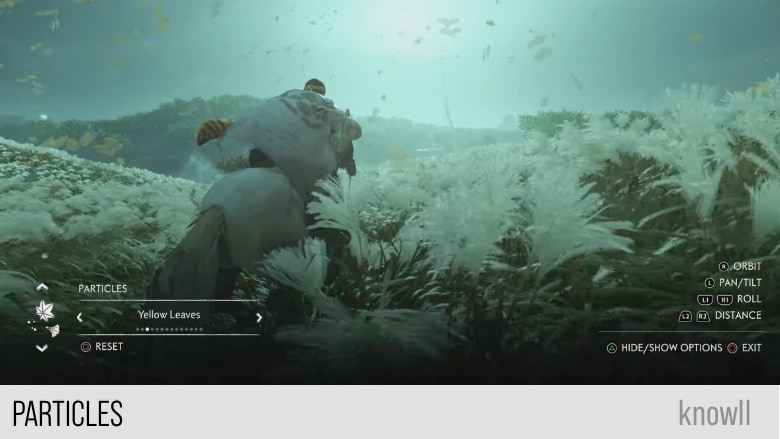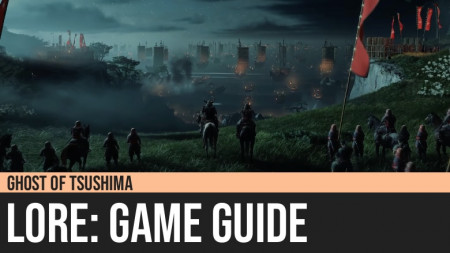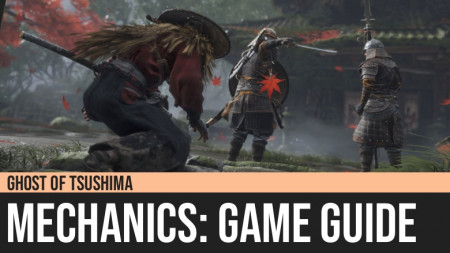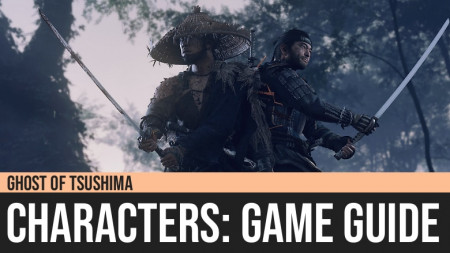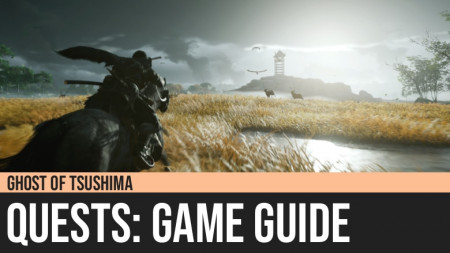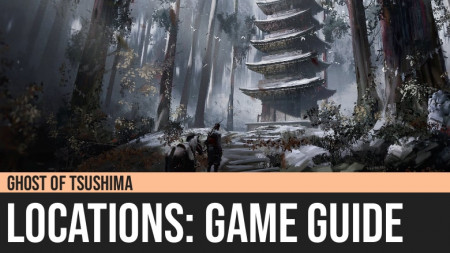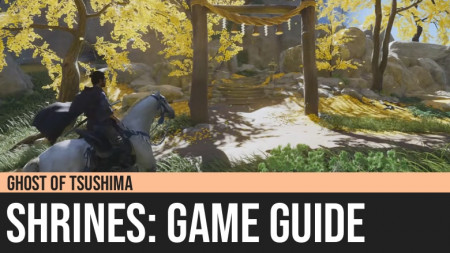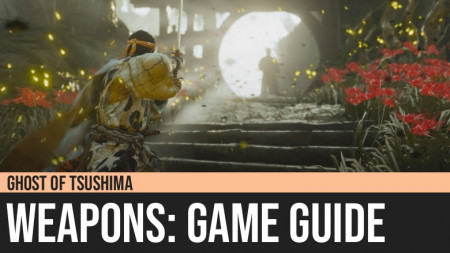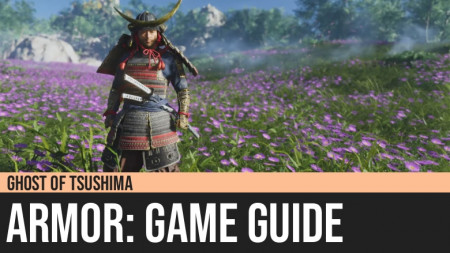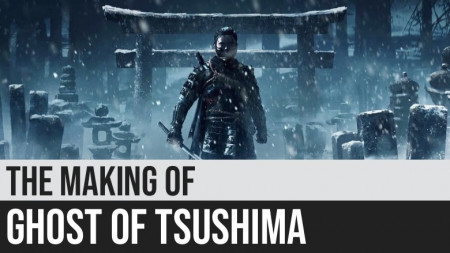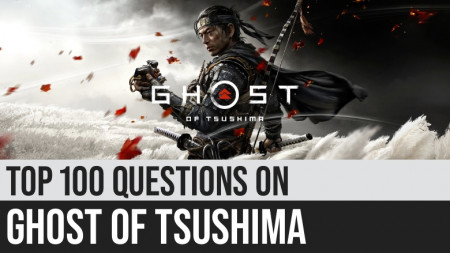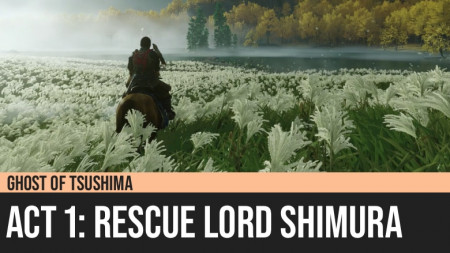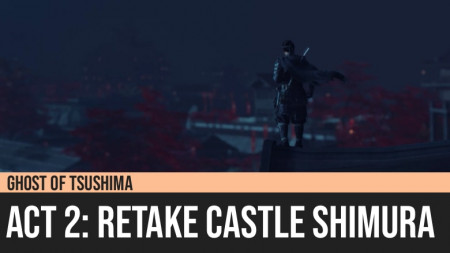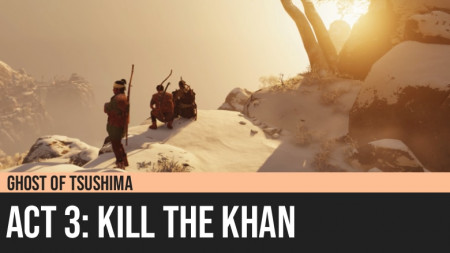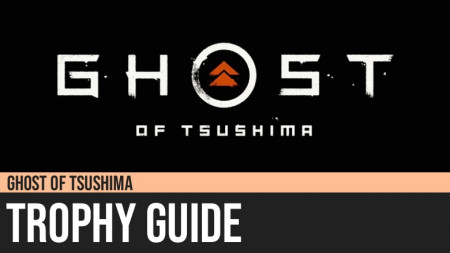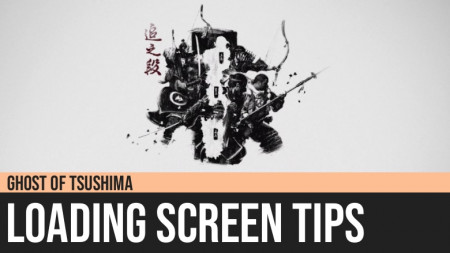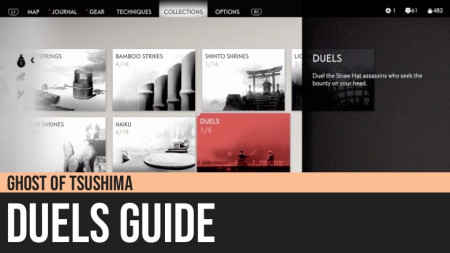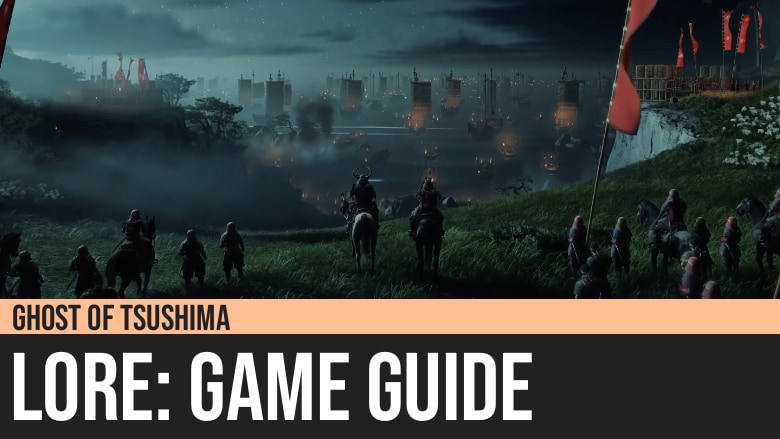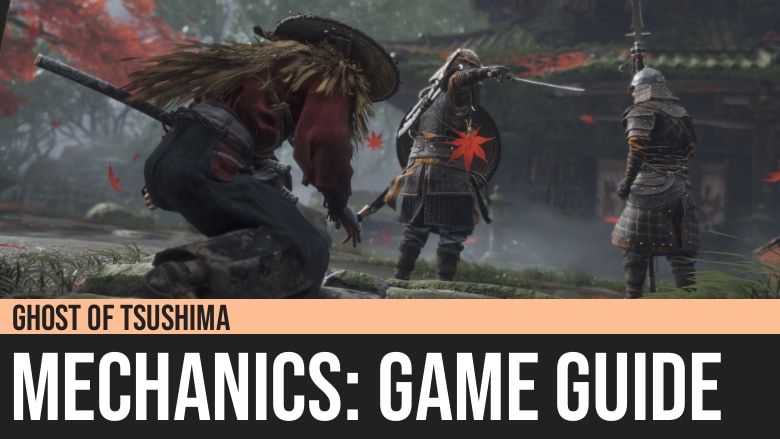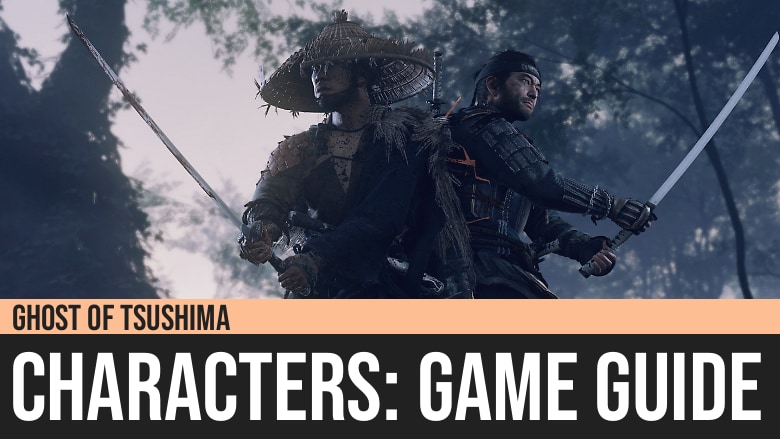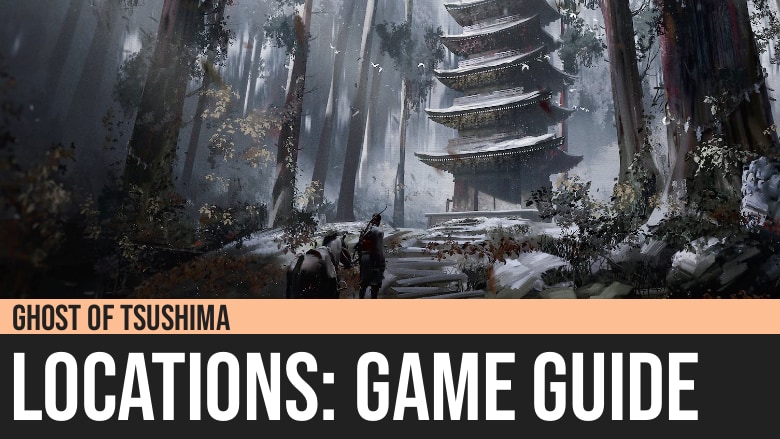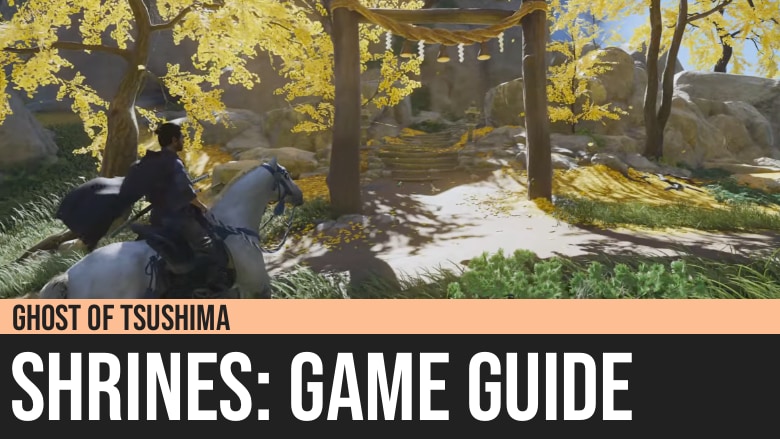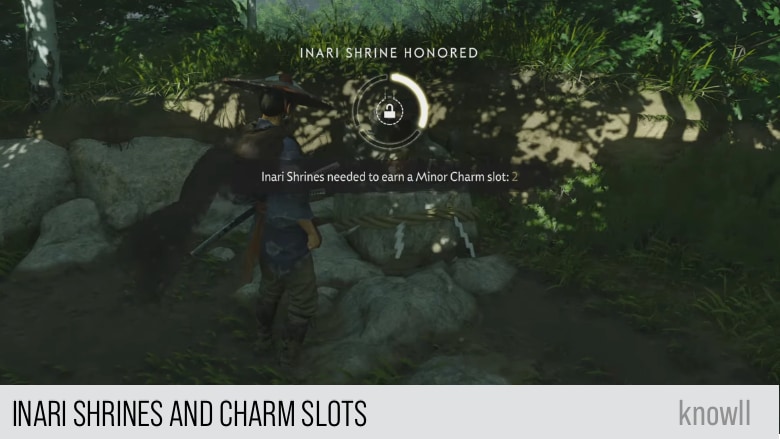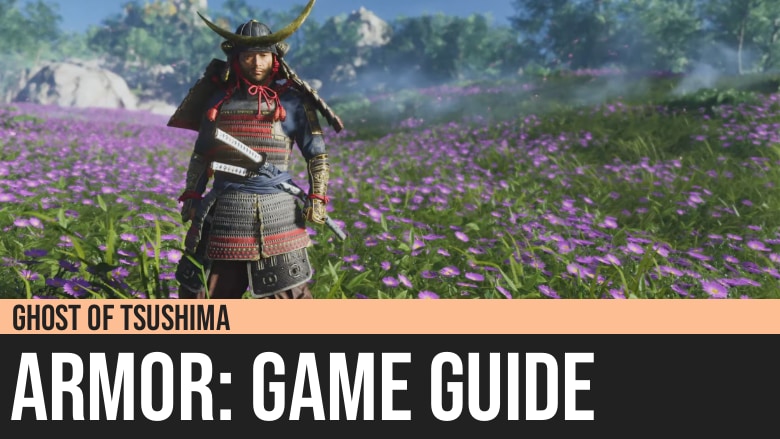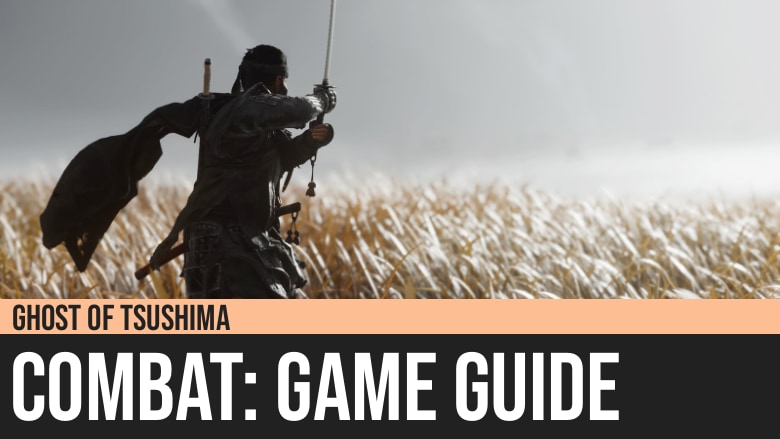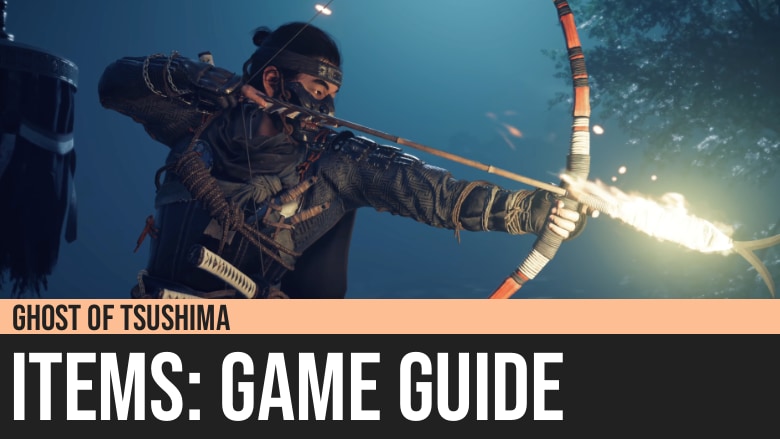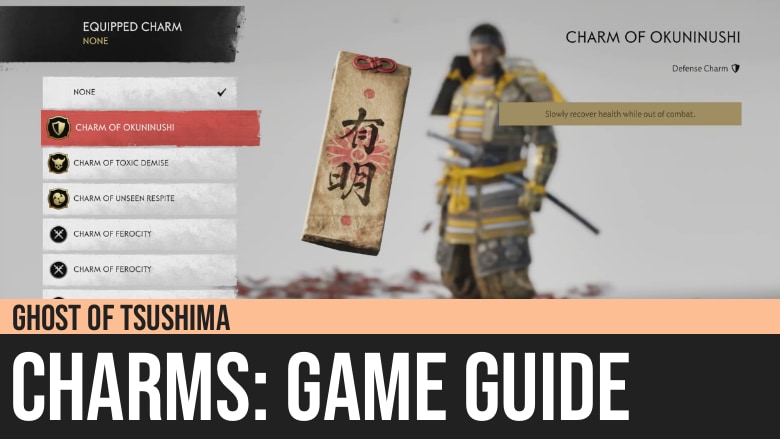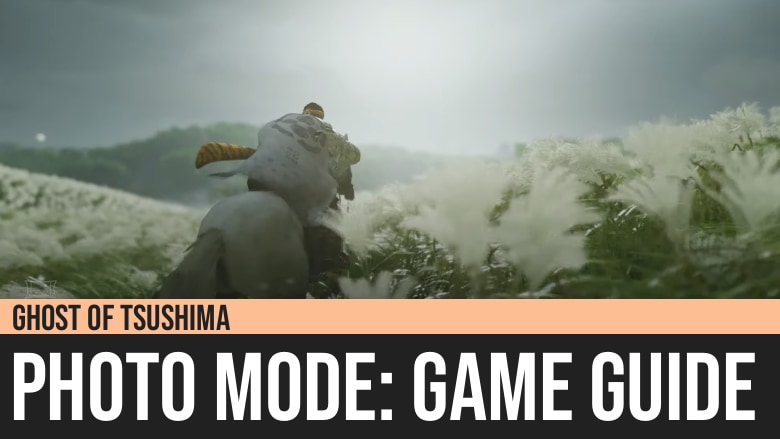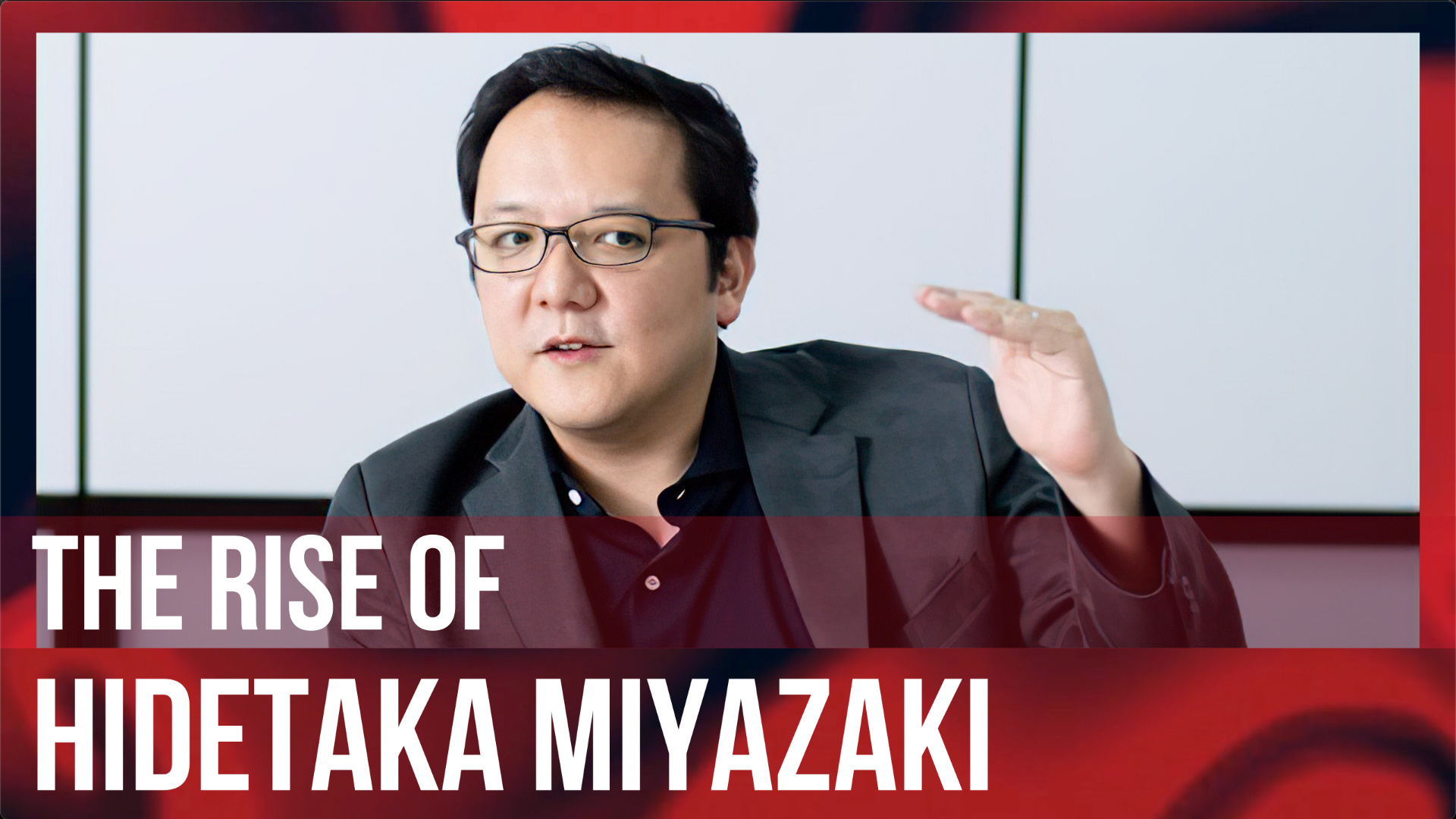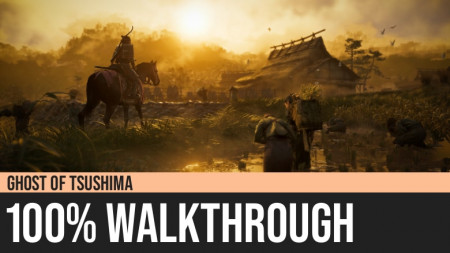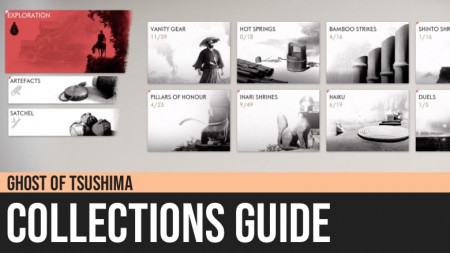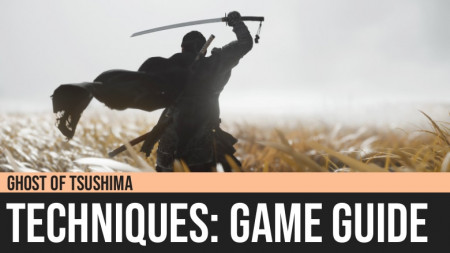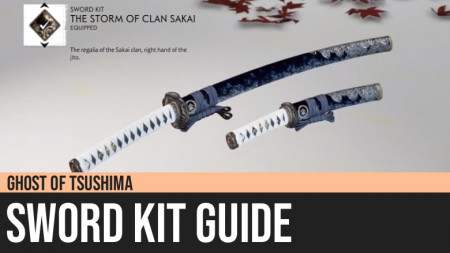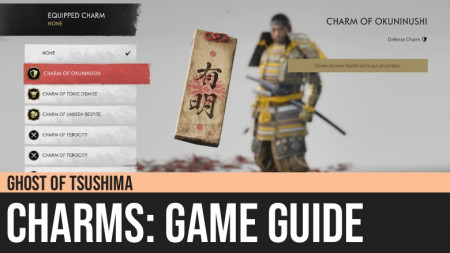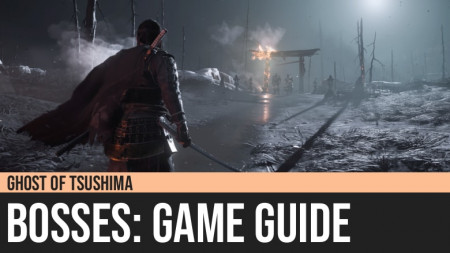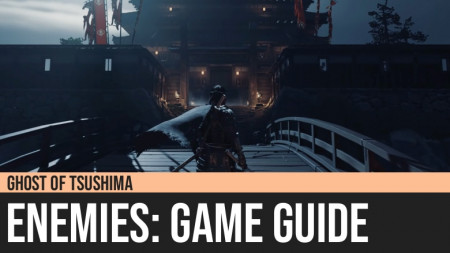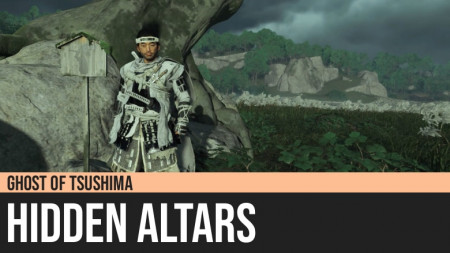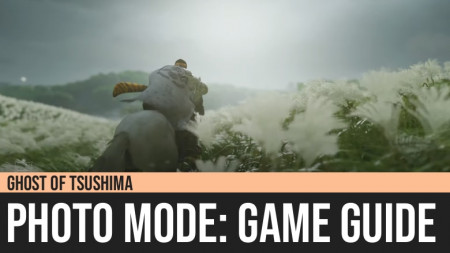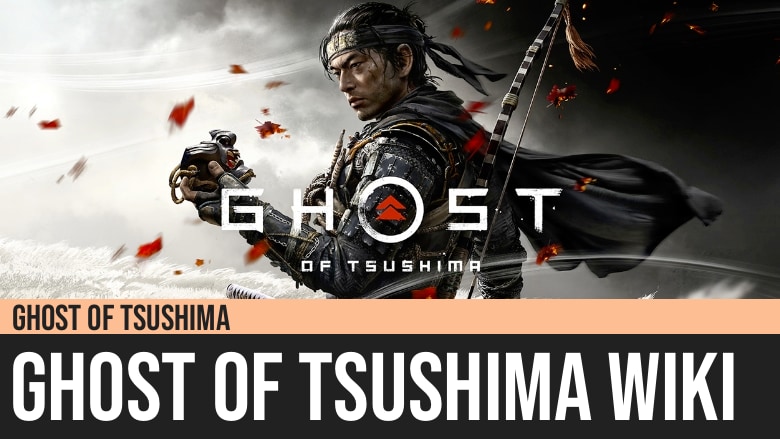
Ghost of Tsushima Wiki
Ghost of Tsushima is a beautiful, open-world, action-adventure game set during the First Mongol invasion of Japan in 1274. It tells the adventure of Jin Sakai, a powerful samurai living in the Island of Tsushima, and his transformation as he journeys to free the island and its people from the Mongol invaders. The Ghost of Tsushima Wiki aims to be your definitive guide in everything related to the game.
Ghost of Tsushima is developed by Sucker Punch Productions, creator of the Infamous and Sly Cooper series, and published by Sony Interactive Entertainment exclusively for the Playstation 4. Its release date is July 17, 2020.
Ghost of Tsushima Lore
The core story of Ghost of Tsushima revolves around the hero Jin Sakai, as he goes in a transformational journey with his desire to defend the Island of Tsushima, its people, and way of life, from the invading armies of the Mongol empire.
To appreciate the adventure of Jin fully, we must look into the history where the game borrows some of the most important characters and plot points that will appear in it.
Historical Foundation of Ghost of Tsushima
The most crucial historical person we must know for this game is Kublai Khan, as he is the impetus that started the series of events that will affect the people of Tsushima Island.
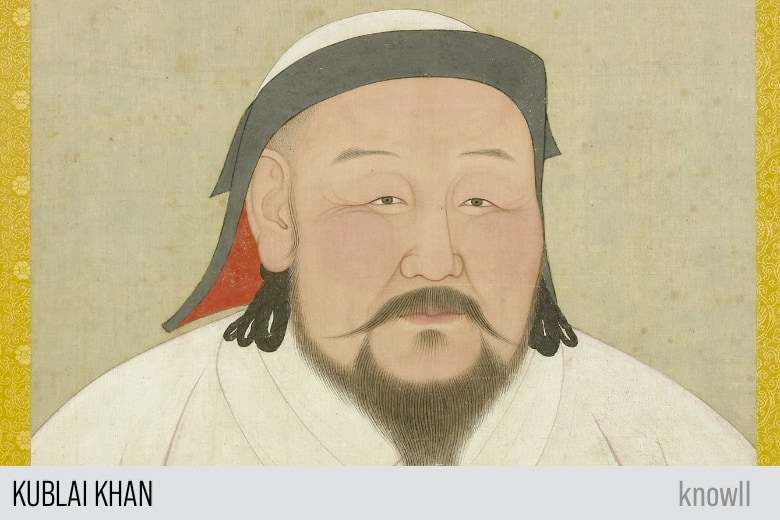
After the death of Genghis Khan, the founder of the mighty and vast Mongol empire, one of his grandsons rose to prominence and became the second most powerful Mongol emperor ever for his achievement in conquering the whole of China.
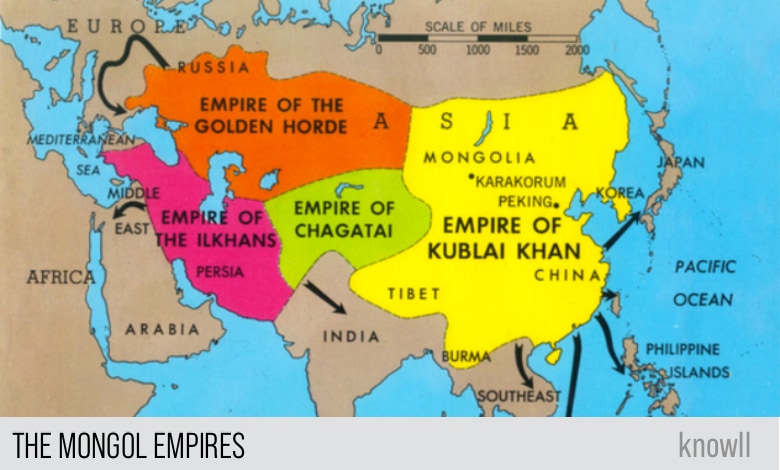
This man's name is Kublai Khan. He will have contemporary rulers for the rest of the Mongol empire, but his rule of China is the most significant, due to its size and cultural heritage.
You can see from the map the scope of his empire. He desires to expand this and conquer the remaining smaller countries of the East and Southeast. These countries are:
- Japan
- Vietnam
- Indonesia
- Thailand
- Burma
- Cambodia
Basically, Kublai Khan wants to conquer every other small country that is not yet part of his empire.
By the time Kublai Khan decided to include Japan in his collection of vassal countries, he has already conquered the Korean territory nearest to Japan. This will later become his launching pad for hundreds of Mongol warships for the Japanese invasion.
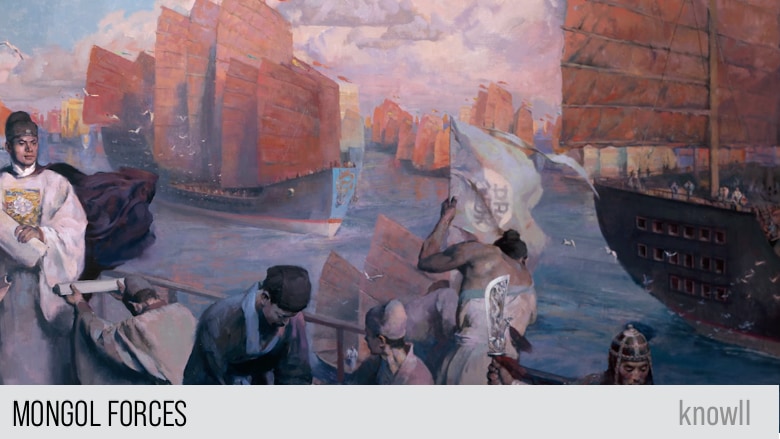
Kublai Khan planned for his warships to first invade two small islands that separate Korea and Japan.
The first of these two small islands is the Island of Tsushima.
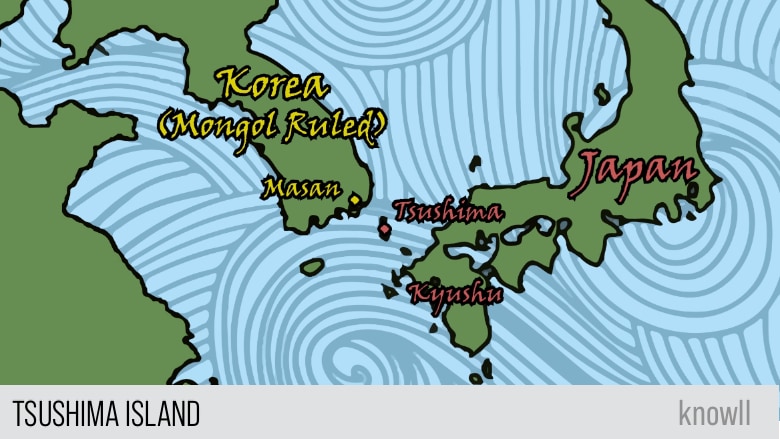
The Premise of the Game
With that historical background, we can now discuss the premise of the game. What is Ghost of Tsushima all about? It is about the transformation of a hero who will do everything in his power to defend the people he loves against the forces that try to harm them.
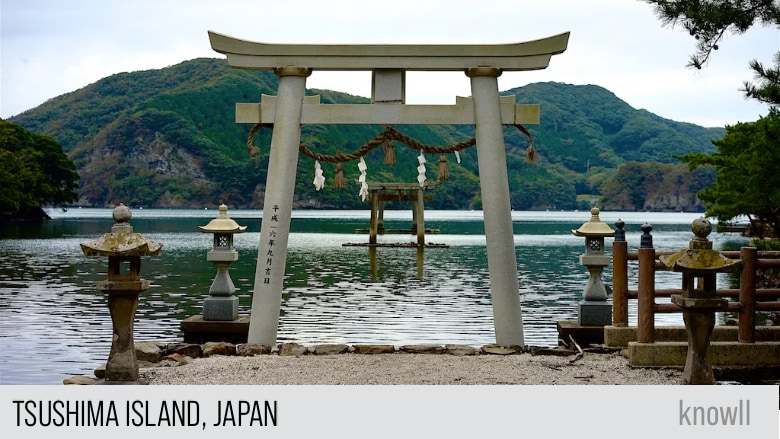
It is a universal premise that all of us can relate to. And it does not select a time period, a race, or a culture to become significant. We all know the value of this premise.
This hero is determined to do whatever it takes, at any cost, to defend his people and regain his home. He must put aside the customs and traditions that have molded him as a warrior to create a new path, the path of the Ghost, and wage an unconventional war for the freedom of Tsushima.
The Ghost of Tsushima
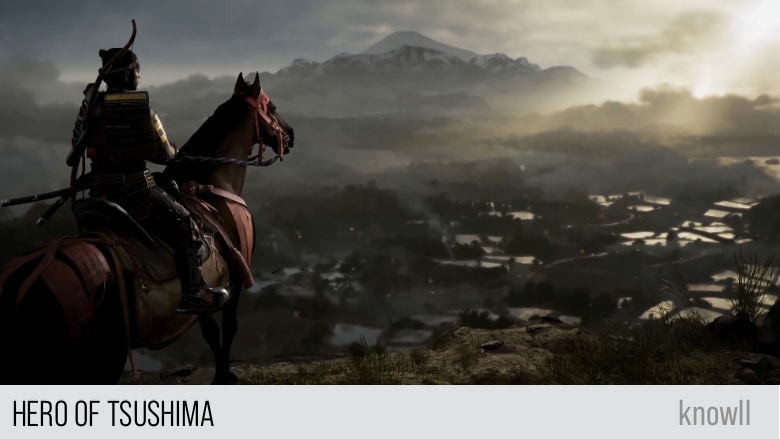
In playing the game, you will become Jin Sakai and make the decisions that will lead to the freedom of the island and the defeat of the invading Mongol army.
While going through this journey, you will meet people that will either support or obstruct you. You will go through major and minor quests that will reveal and reward armor, weapons, items, and secrets that will help you in your adventure.
The Early Life of Jin Sakai
The first important character you will meet in the game is Shimura, Jin's uncle. He is the lord of Tsushima Island and a father figure to Jin.
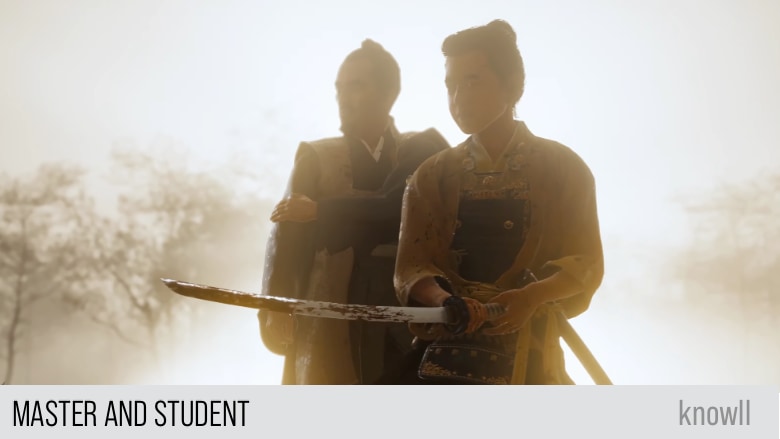
He took care and trained Jin since childhood in the art of the sword and the traditional ways of the Samurai.
One of the first and most important lessons he imparts to Jin is the Honor of the Samurai.
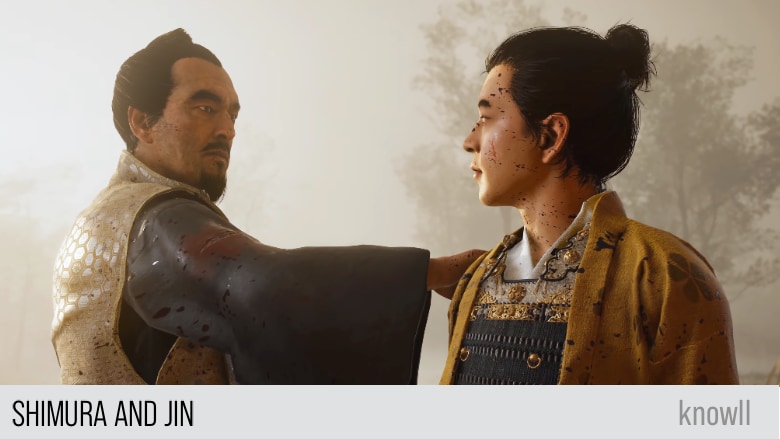
When we fight, we face our enemy head-on. And when we take their lives, we look them in the eye, with courage and respect. This is what makes us Samurai.
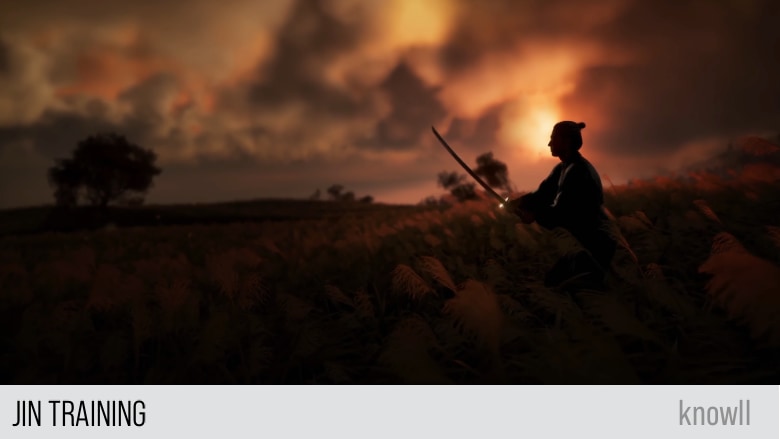
Jin grows up and matures under the guidance of the Samurai Code of Honor. Years pass, and Jin becomes a full-grown man, a warrior capable of protecting his homeland.
The Coming of the Mongols
Of course, we will not have a story if Kublai Khan does not appear somewhere in the lore.
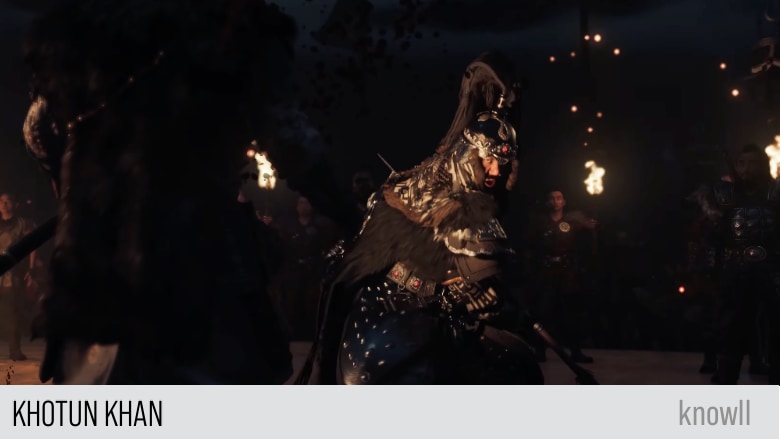
In the game, his name is Khotun Khan, the intelligent, resourceful and ruthless leader of the invading Mongols.
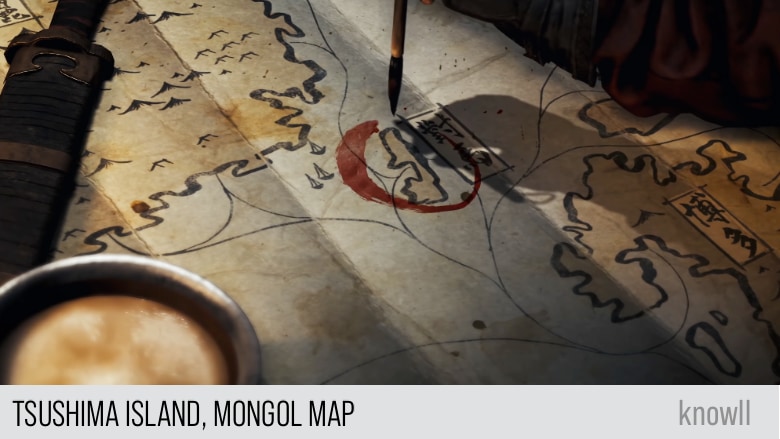
While life in Tsushima moves on peacefully, Khotun Khan was planning the invasion that will drastically alter their lives.
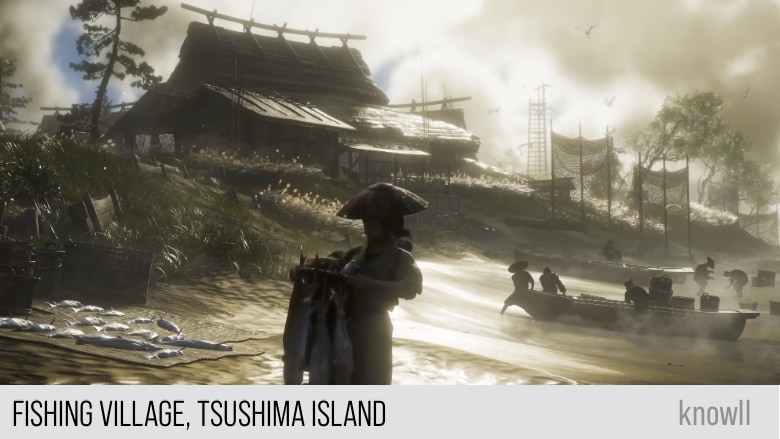
He studied and learned the language, traditions, and beliefs of the villages.
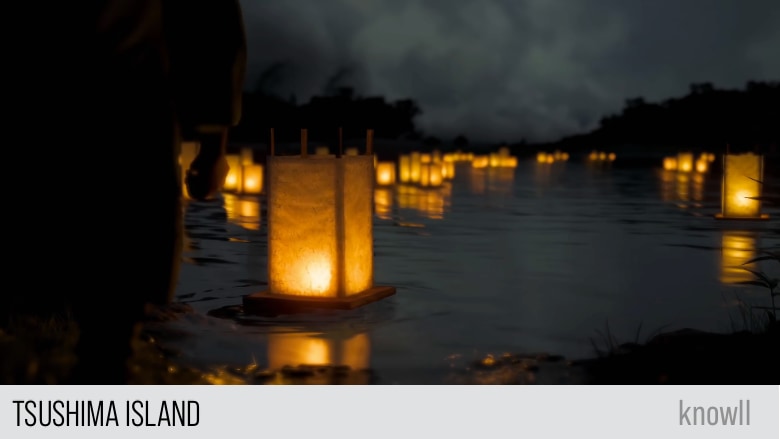
And knows which villages to tame and which to burn.
The Night of the Mongol Invasion
On the night of the Mongol invasion, Shimura leads the Samurai to defend the island. Jin rides with him and provides support to his uncle.
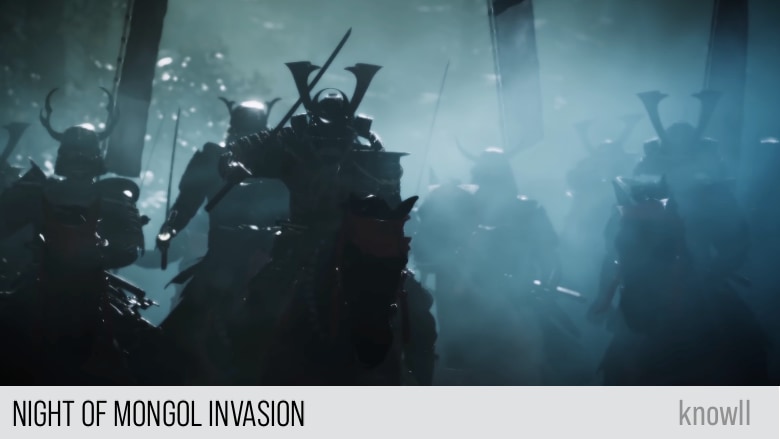
They didn't expect the size of the Mongol armada, as Khotun Khan is not just planning for an attack of Tsushima, he wants to claim the entirety of Japan.
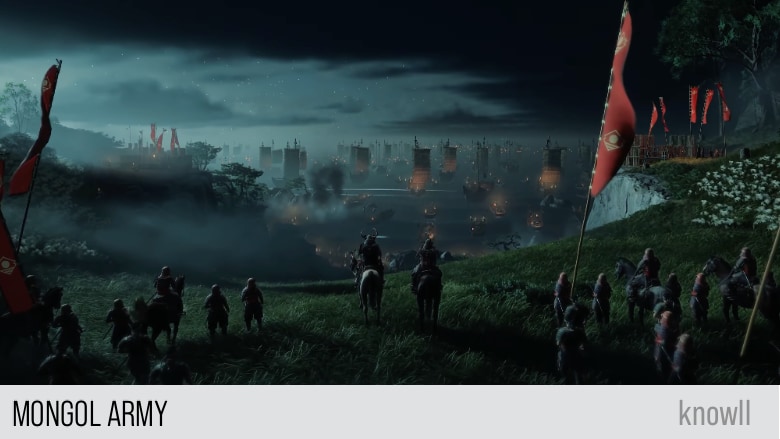
Jin comments that there might be hundreds of them warships. And Shimura answers him with firm courage.
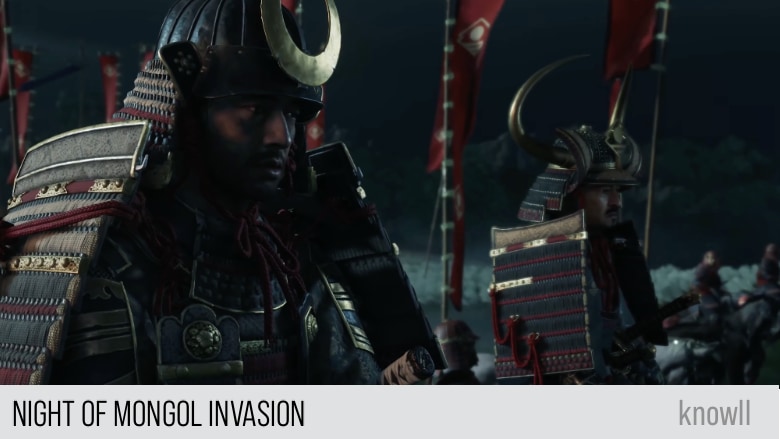
We will face death and defend our home
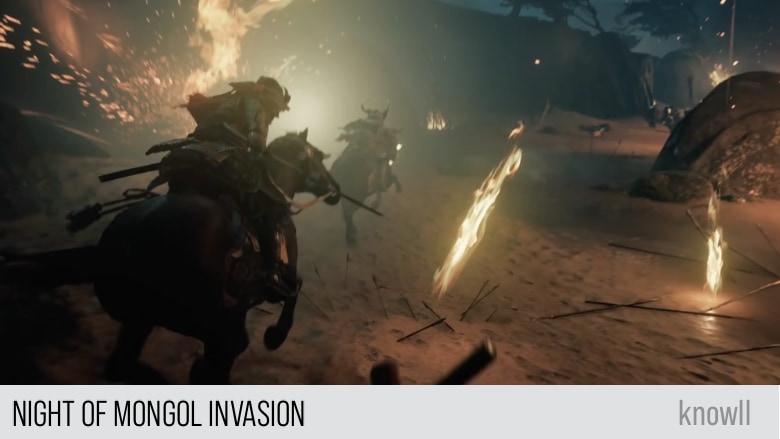
The battle begins, and the Samurai fall under the might of the Mongol army.
The Defeat of the Samurai Army
The Samurai were outnumbered and were not familiar with the fighting style of the Mongols. Their defeat was inevitable.
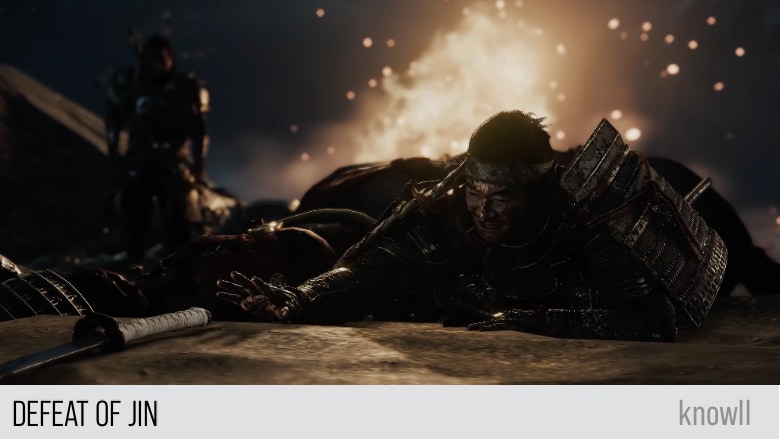
The Transformation into The Ghost of Tsushima
As though a miracle, Jin survives the night of the invasion, and promised to have his revenge, to free his home and his people from the hands of the Mongols.
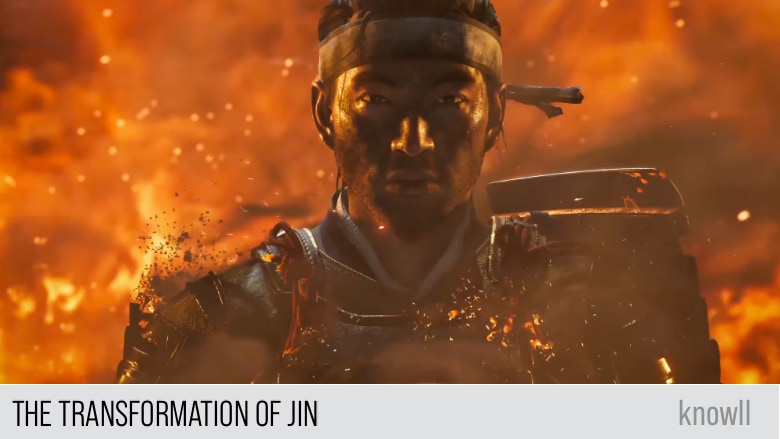
But he will not be able to do this as a Samurai. He must transform into something that can win against the Mongols, even if it is against the guidance and teachings of his old master.
If you continue on this path, you will be no better than the mongols. I trained you to fight with honor.
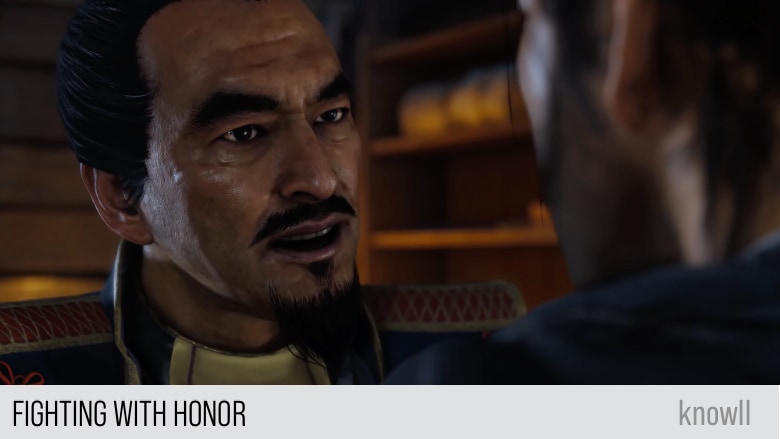
He will give up his honor to achieve his goal. He will become the Ghost of Tsushima.
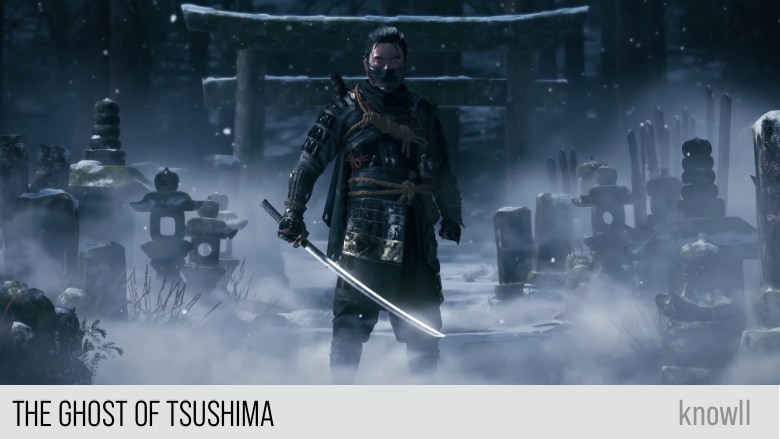
I am Samurai, but I will sacrifice everything for my home.
Game Mechanics
Starting the Game

Before starting the game, it is important to know what settings you have to choose for your gameplay. This includes:
- Audio Output
- Difficulty Levels
- Voice Tracks
- Samurai Cinema
Audio Output
For the best experience, you can select the option that matches your audio setup. The following are available options.
- Home Theater
- Bookshelf Speakers
- Sound Bar
- Night Mode
- Headphones
- Headphones (3D Audio)

If your headphone supports it, you might choose the Headphones (3d Audio).

Difficulty Levels
Ghost of Tsushima has a difficulty setting, which you can set before even starting the game. You can also change this while playing.
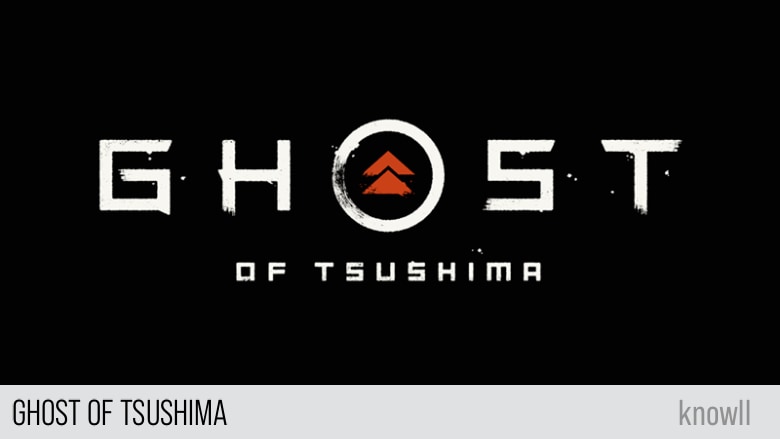
The game has three levels of difficulty.
- Easy
- Normal
- Hard
Easy Difficulty
For players who want to experience Jin's story and explore the island of Tsushima with minimal challenge.
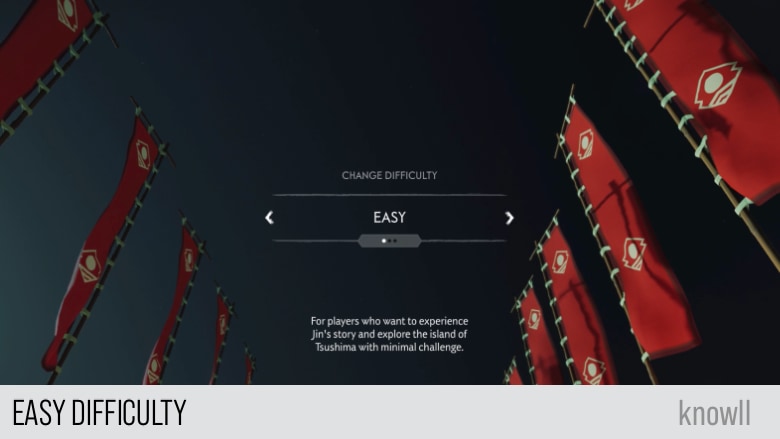
Medium Difficulty
For players who want a well-rounded gameplay experience with a moderate challenge.
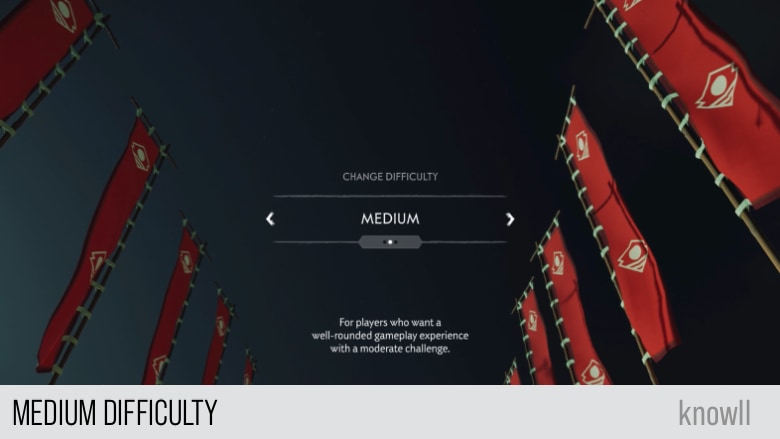
Hard Difficulty
For players unafraid of death who are brave enough to face the ultimate challenge.
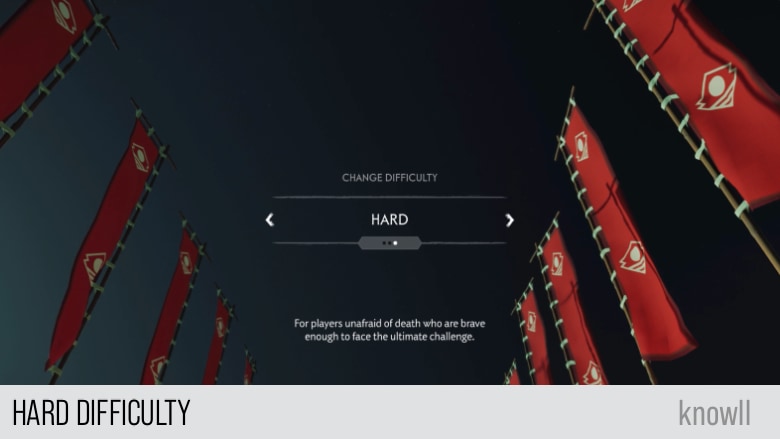
On Hard mode, the game is fair but very challenging. The enemies are more aggressive, and the player must be precise to pull off extraordinary moves. In comparison, Easy mode is for players who want to explore the Island, enjoy the flow of the story, and still be occasionally tested by a worthy opponent.
No matter which difficulty players choose, the health of the enemies will be the same. It will never be increased. This is to maintain the deadliness of the katana.
The combat is all about the player's skill.
Voice Tracks
You have the option to select the language as well as a special experience unique to this game.
Standard
English dialogue without any subtitles.
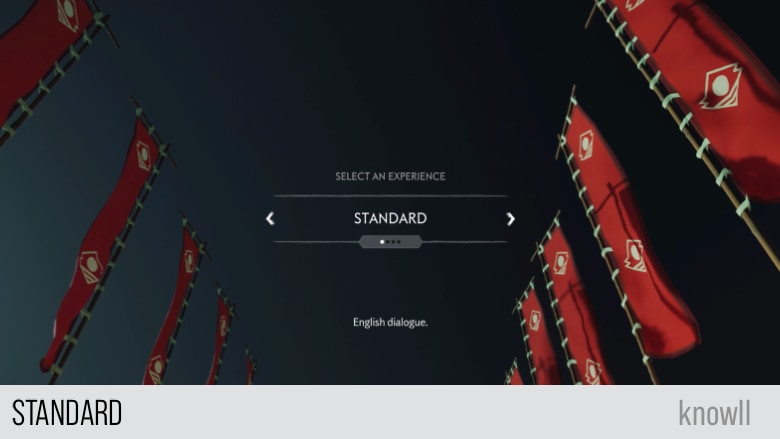
Subtitled
English dialogue with English subtitles
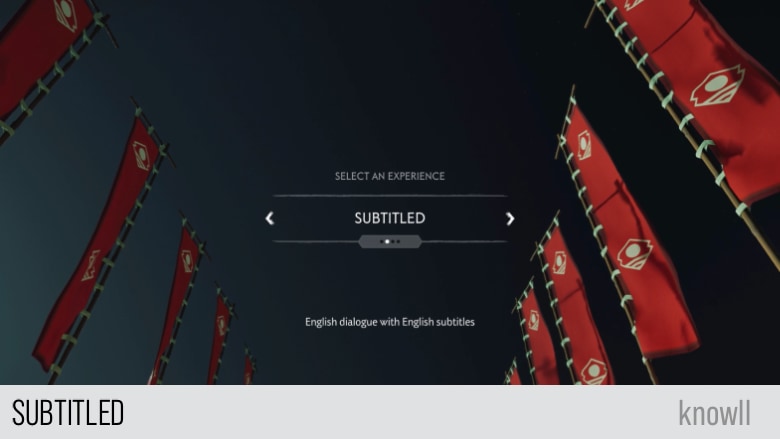
Samurai Cinema
Japanese dialogue with English subtitles.

Kurosawa Mode
Not just a voice option, but a completely unique experience for the game. Black and white filter with Japanese dialogue and English subtitles. Inspired by the movies of legendary filmmaker Akira Kurosawa.
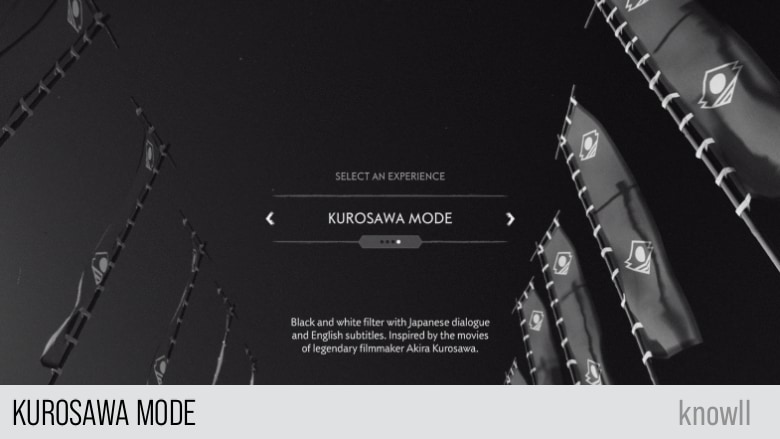
Japanese Voice Tracks
The player can choose Japanese voice tracks with subtitles before the first scene of the game even begins.
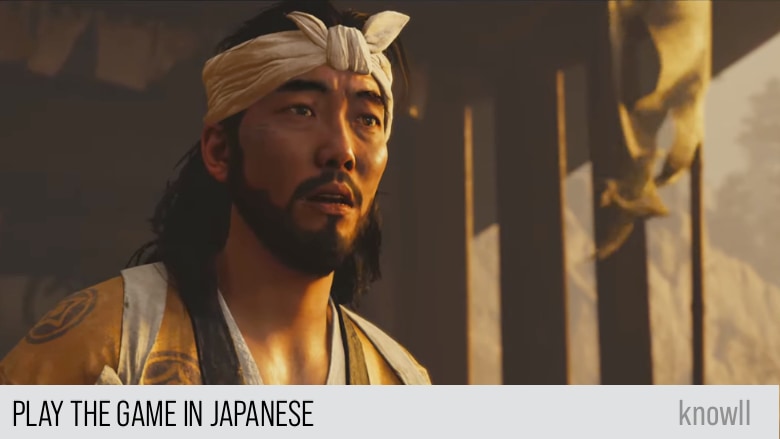
Kurosawa Mode
Sucker Punch is a huge fan of Samurai film, so they let you play the game as though you are playing your favorite Samurai movie. They created a windy, black-and-white film-grained out mode that you can turn on from the very start of the game.

Menu Interface
The menu of the game includes the Map, Journal, Gear, Techniques, Collections, and Options. We have separate guides for each of them.
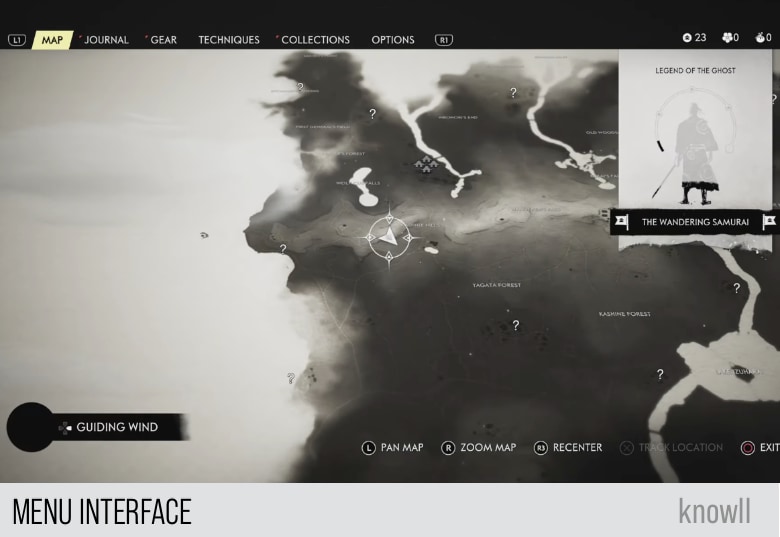
Options and Accessibility
In your playthrough, you have available options for the following.
- Gameplay
- Audio
- Display
- Accessibility
If you would like to see the options for each category, see our Menu Interface guide or click the image below.
Legend of the Ghost
Core to the overall gameplay is the concept of the Legend of the Ghost. This is visible in the top-right of the menu. It gradually accumulates as you go on your journey as Jin Sakai. Through quests and normal progression of the story, it will increase.
Quests contribute varying amounts to the gauge.
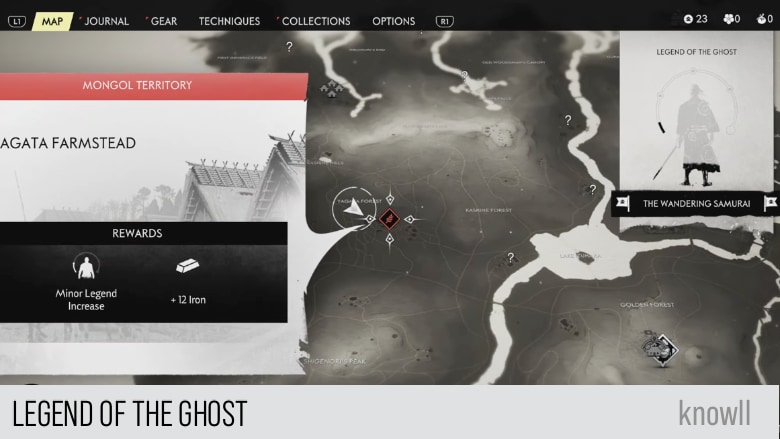
Guiding Wind
Exploration is at the heart of the open-world games designed by Sucker Punch. And with Ghost of Tsushima, they gave their best to make the game as immersive as can be. They continuously iterated on an interface where the Island can guide you in your exploration in the most thematic and immersive way possible.
The result of this design principle is what they call the Guiding Wind.
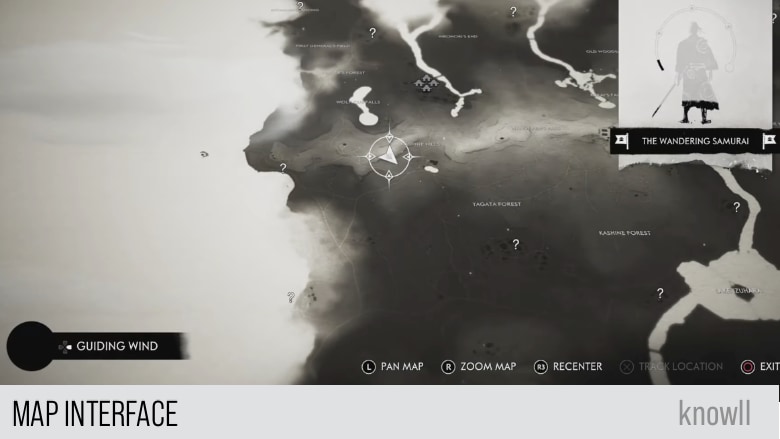
Instead of using waypoints and intrusive interfaces, Sucker Punch designed the wind in the game to guide the user towards the direction he wants to go to.
You can mark your destination, as shown below.
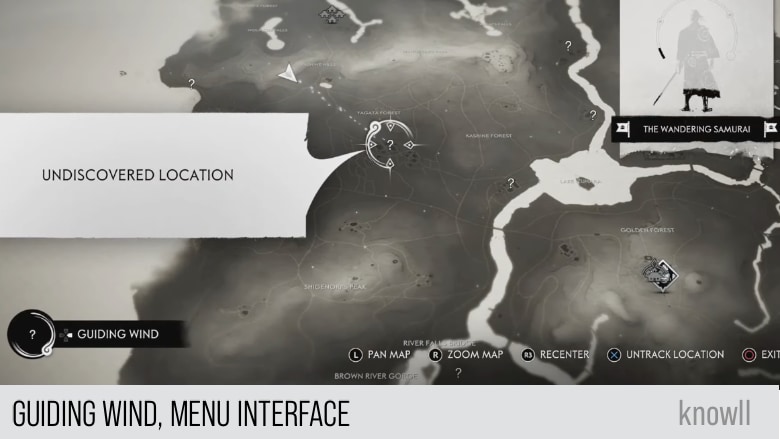
And now you can call a gust of wind to point you in the right direction.
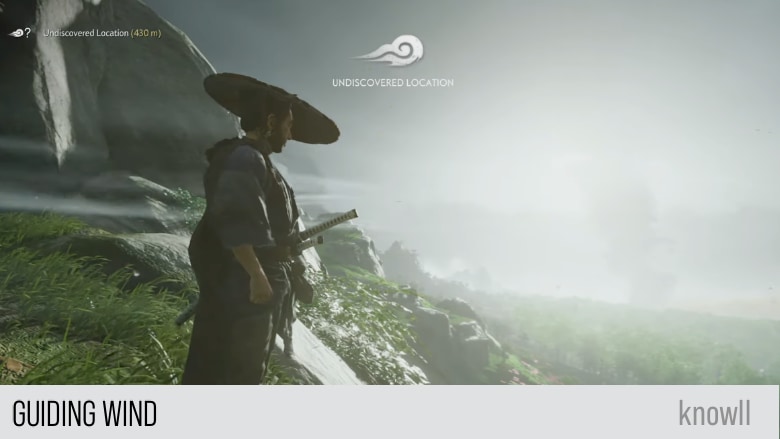
Quick Menu
The game gives you three actions that you can easily initiate via a quick menu.
- Guiding Wind
- Calling the Horse
- Healing
You can call the Guiding Wind easily and anytime through the quick menu, as shown below. It maintains the immersiveness as you don't have to open a big map that takes you out of the game.
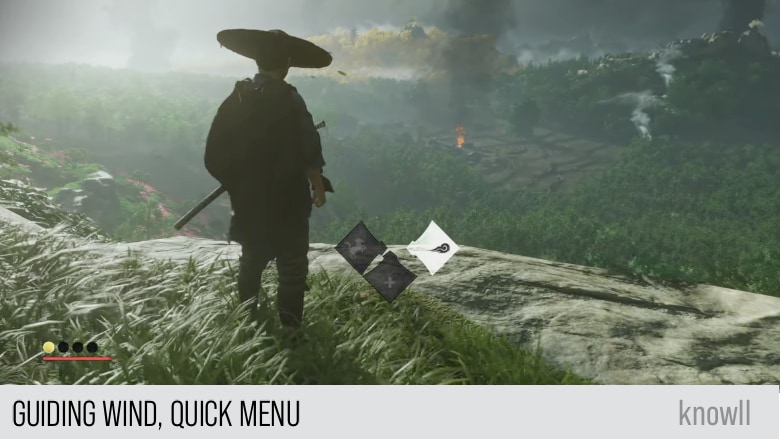
Guiding Wind Destination
An icon shows up when you are about to reach your destination. You can also see the icon of the wind showing on top of your target. As you move closer to the target, the icon gauge becomes full.

And once the gauge is full, you will see the message that you have arrived at your tracked location.
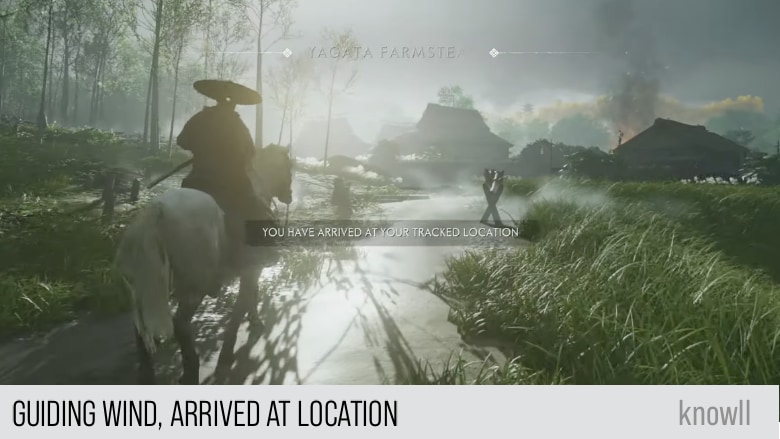
Calling your Horse
Using the same interface, you can call your horse.
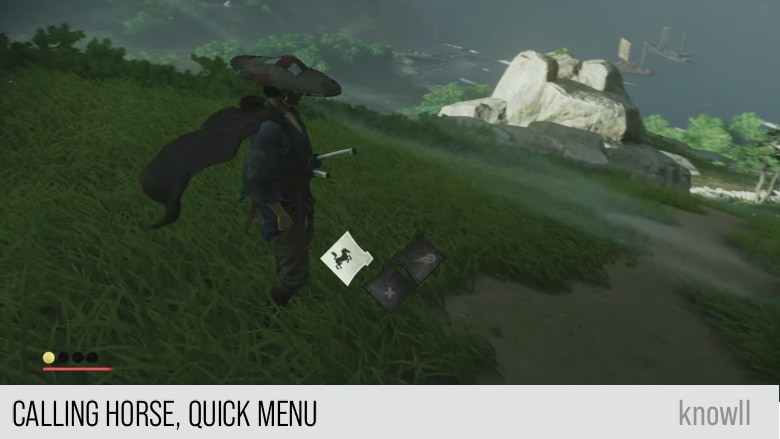
Where does the horse come from?
Jin's partner in his adventure is his horse. At the beginning of the game, there is an opportunity to select the horse you want to go on this journey with.

Mounting the Horse
Press R2 to mount the horse.
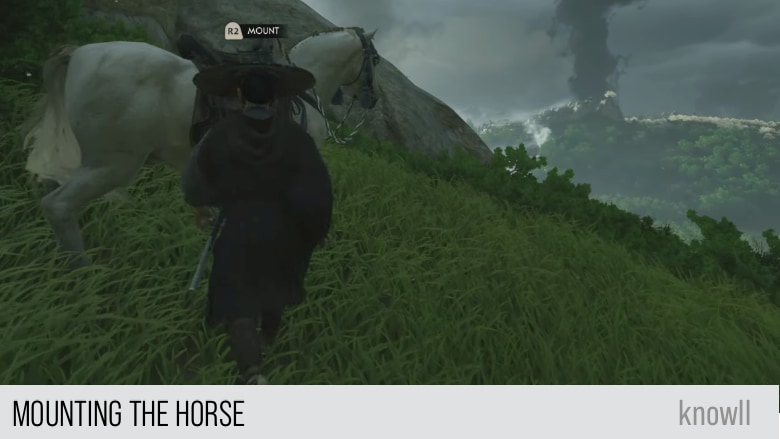
Healing
The third quick menu item is Healing. You are going to consume a mechanic called Resolve to do this. Continue reading below to find out what Resolve is.
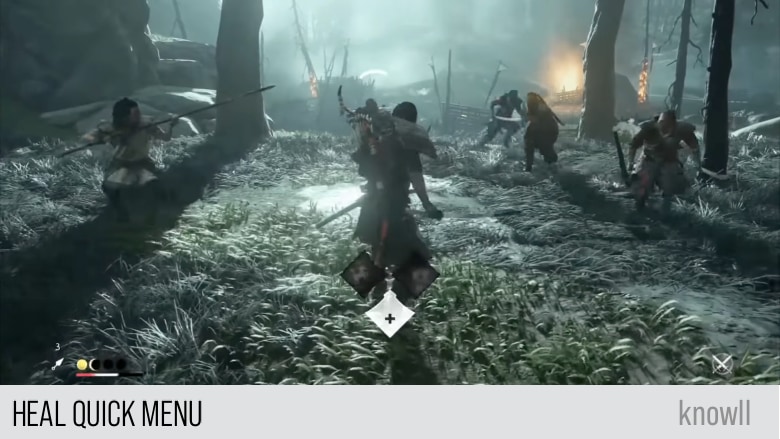
Material Gathering
You can gather materials without stopping, just press R2.
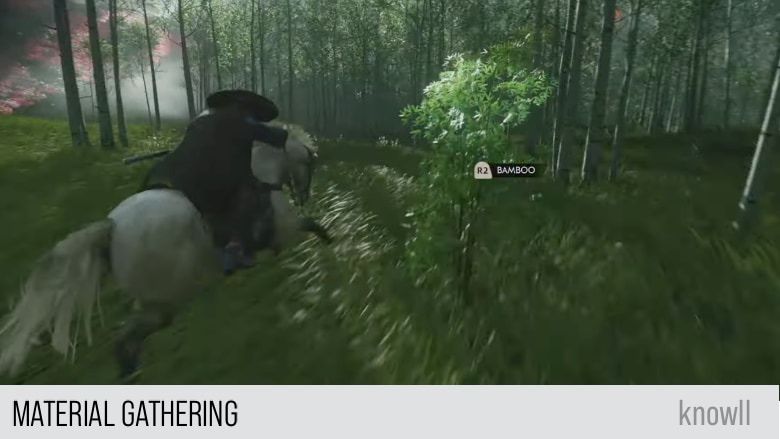
Flash of Insight
When there is an event or people near you, you will observe a flash of light that tries to notify you of such an event.
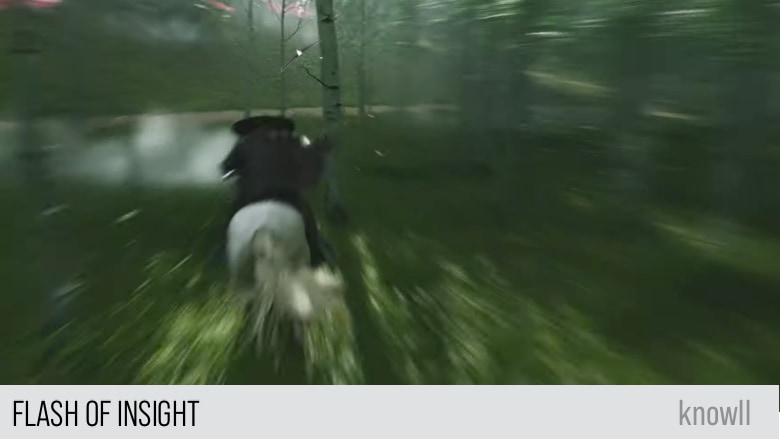
You will see the icon as well, and it points you to the direction of this event.
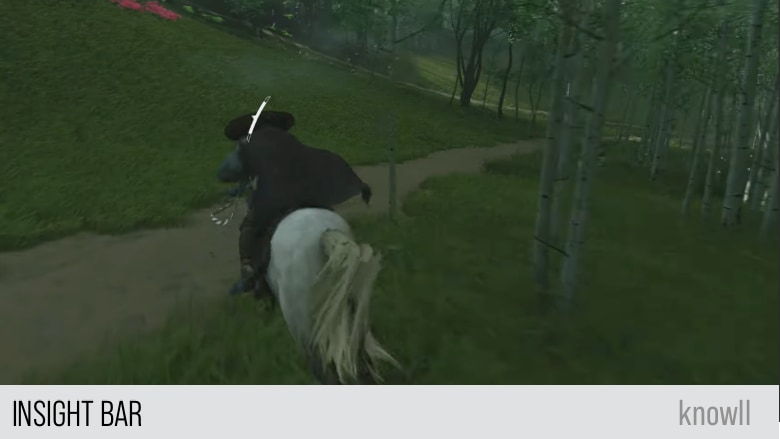
The icon for animals is different. In this case, it's for a bear.
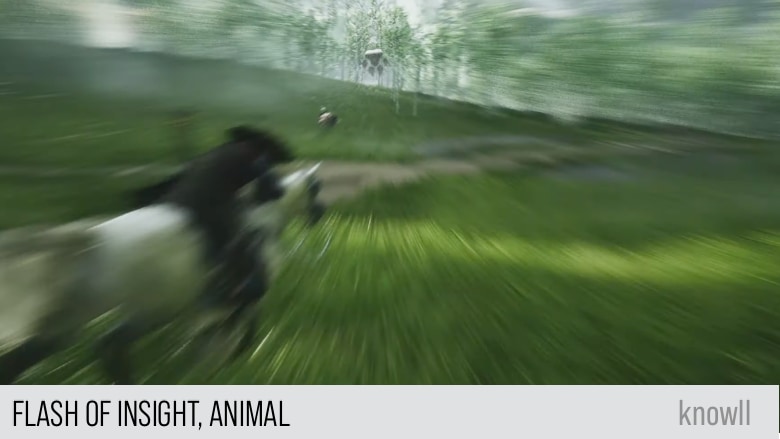
This flash of insight and icon happens as well while walking, not just when riding a horse.
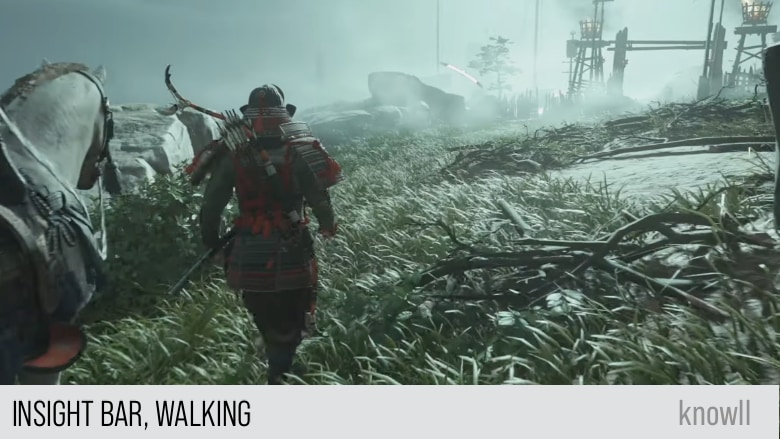
Smokestacks
Smokestacks indicate people in need of help. It's a sample of emergent gameplay. It's for things that you didn't know in advance and would not know unless you actually see it. It is for discovery, as compared to the Flash of Insight.
The game has other ways of informing you of interesting events:
- Peculiar and odd-shaped trees
- Animals trying to get your attention

Bird Guides
While traveling, an animal might suddenly appear and get your attention, like in this scene below, Jin was riding the horse, and the bird showed up. It will lead you to points of interest, such as hidden locations.
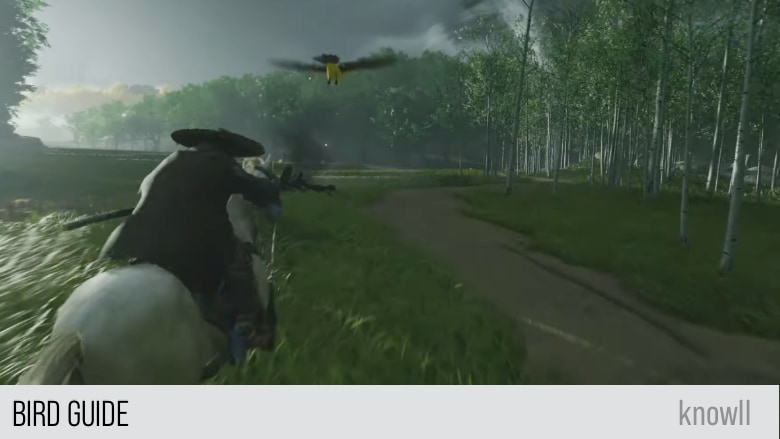
The bird will land into a point of interest.
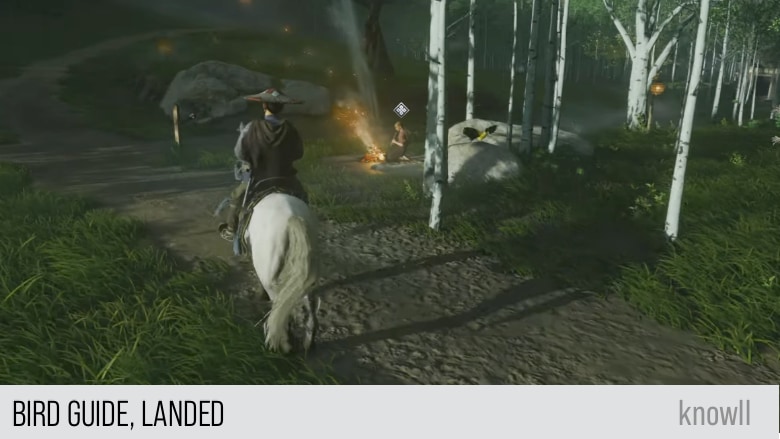
Foxes
Foxes will guide you to hidden shrines across the Island. This is the best way to discover hidden Inari Shrines.

Talking to People
While exploring, you will meet people. To talk to them, press R2.
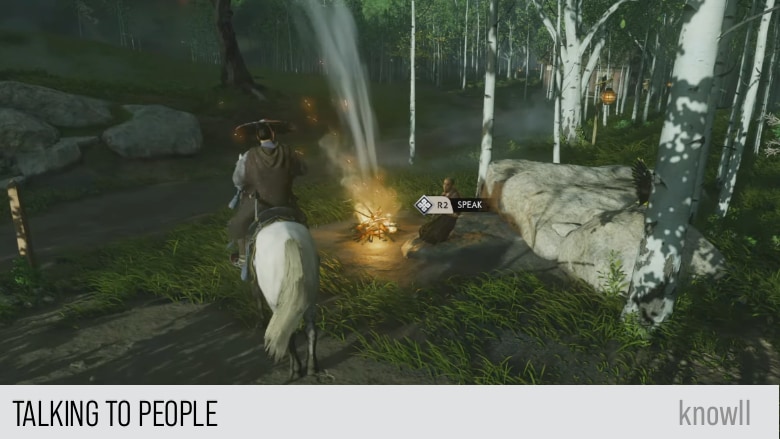
Collecting Rare Resources
Explore abandoned buildings to collect rare resources. To gather supplies, just walk through them and press R2.
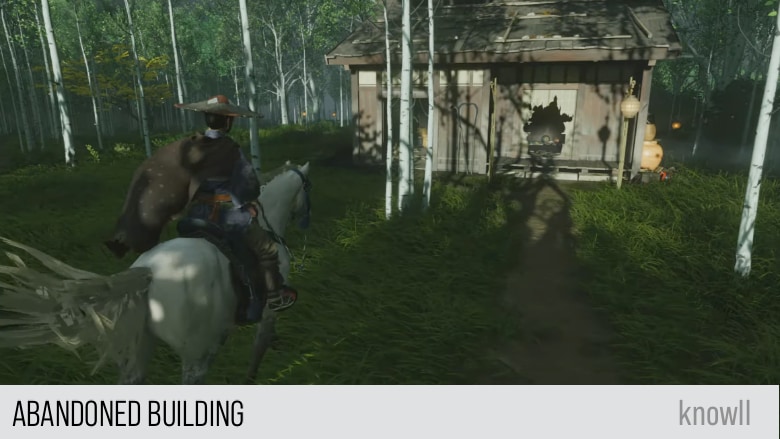
Fast Travel
Fast travel is unlocked by visiting a location. In this sample, it is for a shrine.
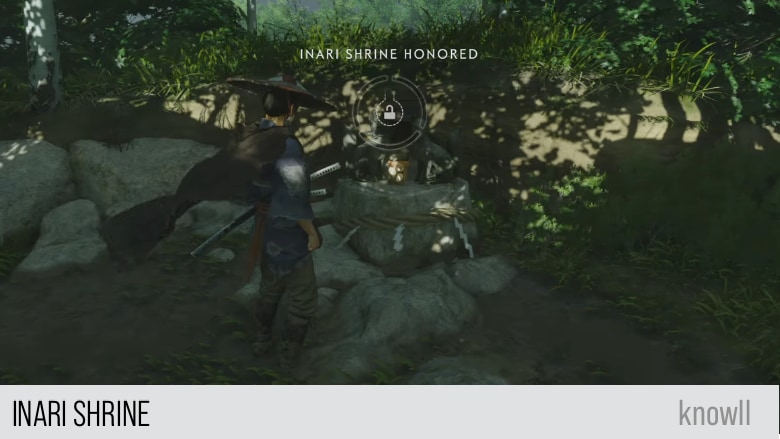
Grapple Hook
Jin can jump and traverse open spaces through his grappling hook. Press R2 to initiate it.
You can use the grappling hook to climb or swing across gaps.
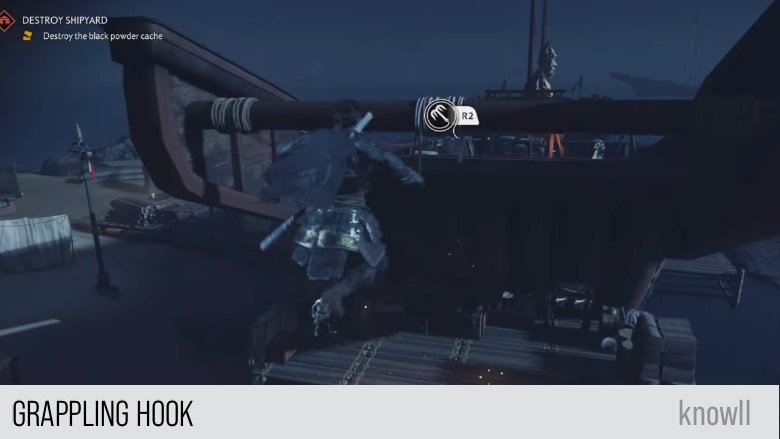
Day/Night Cycle
The game has a day and night cycle. You might want to play as the Samurai during the day, and as the Ghost at night.
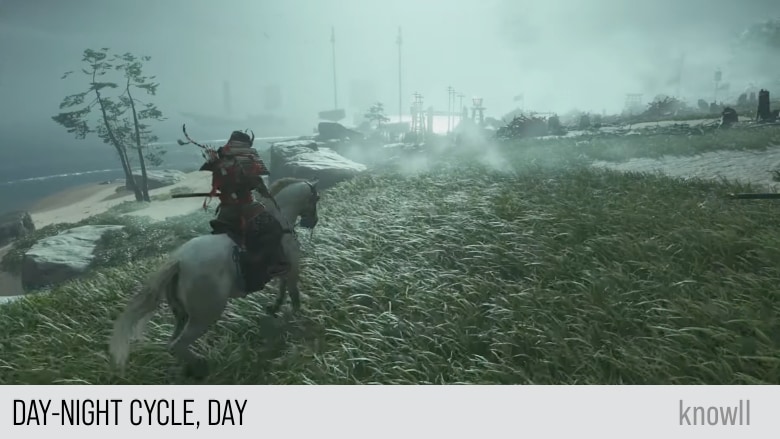
Dynamic Weather
The game also has dynamic weather conditions that you will experience throughout your adventures in Tsushima. Some of them are tied to certain regions to give more personality and flavor to them, while others are tied to story moments.
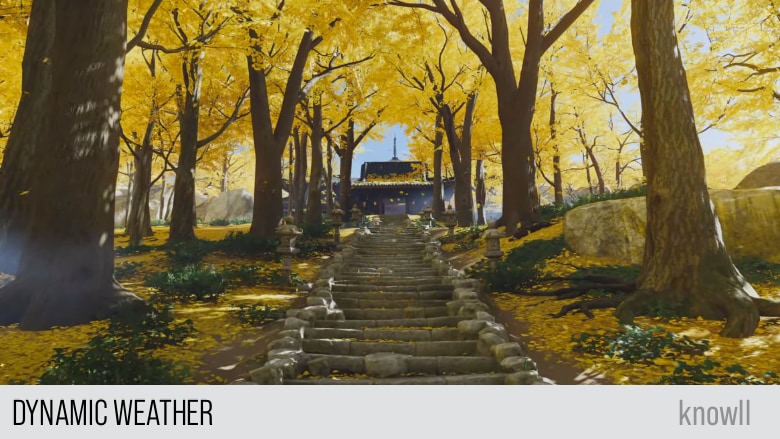
Ledge Hang
Jin can also move through ledges and cliffs.
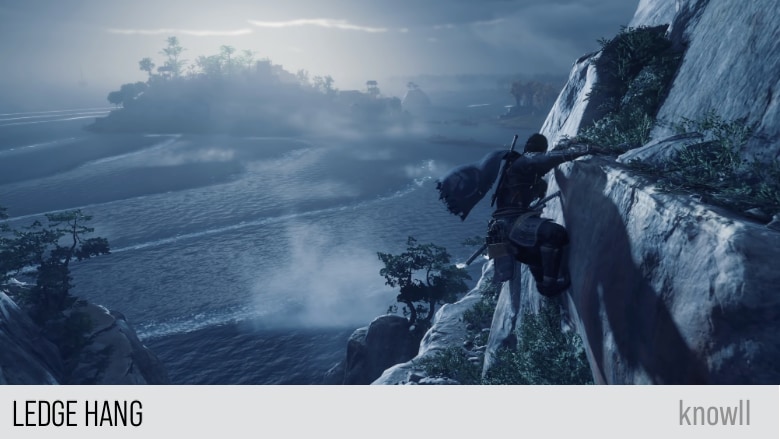
Characters Guide
The game's major character is Jin Sakai, a powerful samurai who undergoes a transformational journey in his quest to free his home and its people from the hands of the invading Mongol empire. In this journey, you will meet the characters who support him in this mission, and those who oppose him.
Jin Sakai
Jin Sakai grew up under the guidance of his uncle Shimura, the lord of the Tsushima Island, and his master in the art of the sword.
One of the earliest and most important lessons Shimura imparts to Jin is the Honor of the Samurai.

When we fight, we face our enemy head-on. And when we take their lives, we look them in the eye, with courage and respect. This is what makes us Samurai.
Years pass, and Jin becomes a full-grown man, a warrior capable of protecting his homeland.

Masako
Masako is a powerful samurai who is going to help Jin in fighting the forces of the Mongol army.
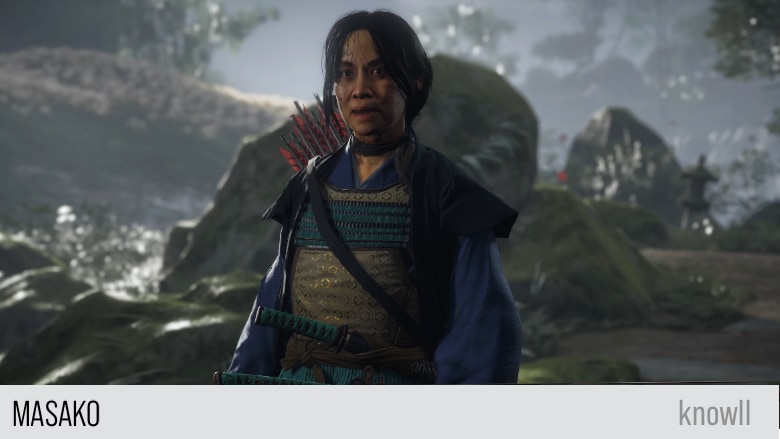
Masako Fights Jin
They will join forces but will face conflicts as well, culminating in a duel between them.
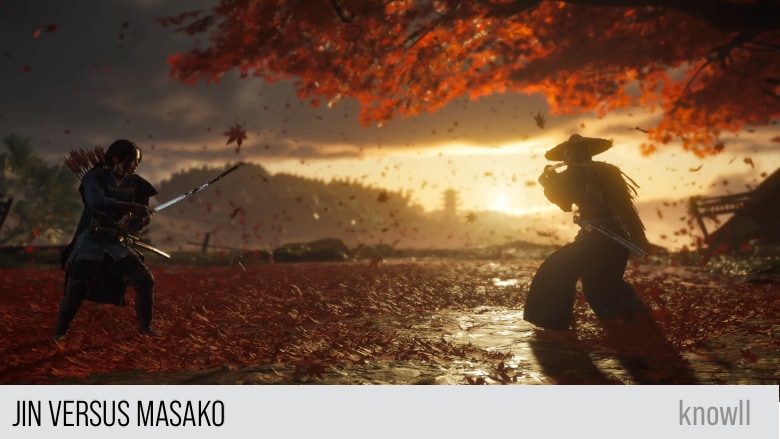
Shimura
Shimura is the lord of Tsushima Island and uncle and mentor of Jin. He trained Jin as a young boy on the art of the sword and in the code of the Samurai.

As Jin undergoes his transformation as the Ghost, Shimura reminds him of the old teachings he shared with him on what it means to be a Samurai.

Khotun Khan
Khotun Khan is the intelligent, resourceful, and ruthless leader of the Mongol army who was bent on conquering Japan. He's a brutal, unrelenting enemy that Jin will quickly learn not to underestimate.

Locations Guide
Exploring the Island of Tsushima is done best with the company of your horse.
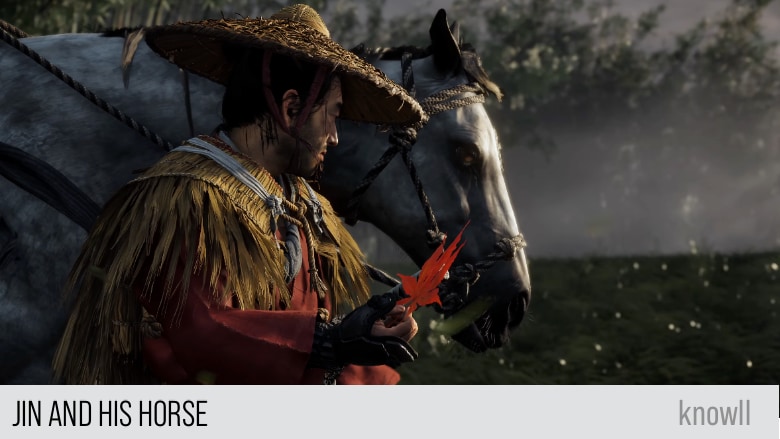
Reaching a Location
When you reach a location, the quest related to that location will show up, plus bonus
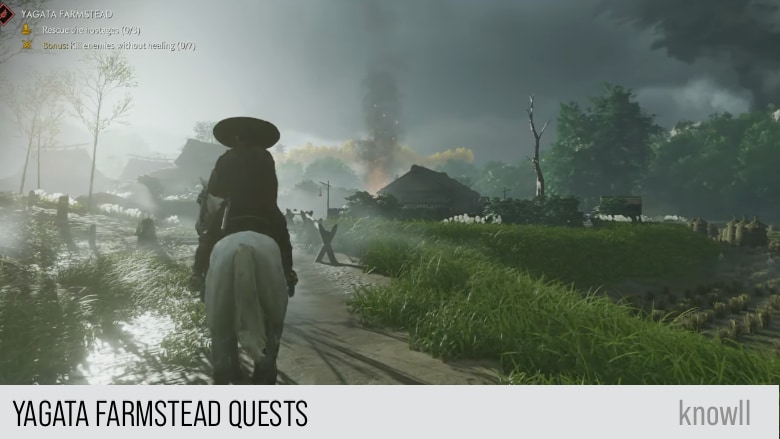
Location Rewards
Locations provide rewards and rare collectibles, as shown below. Once you visit a location, you will be able to return to it with Fast Travel.

Shrines Guide
Ghost of Tsushima's shrines enable you to unlock slots for charms. Omamori charms are items that you can equip on slots and that give you passive bonus abilities for defense, stealth, and utility.
The shrines are distributed all over the Island of Tsushima and can be found by exploring every location that you can visit.
Foxes and Inari Shrines
Foxes will guide you to hidden shrines across the island.

Honoring Inari Shrines
After finding a shrine, approach it, and the action for honoring the shrine will appear.

After honoring the shrine, you will see how many more are needed to earn a charm slot.
Weapons Guide
Sakai Storm
The most important weapon in the game is Jin's katana, Sakai Storm.
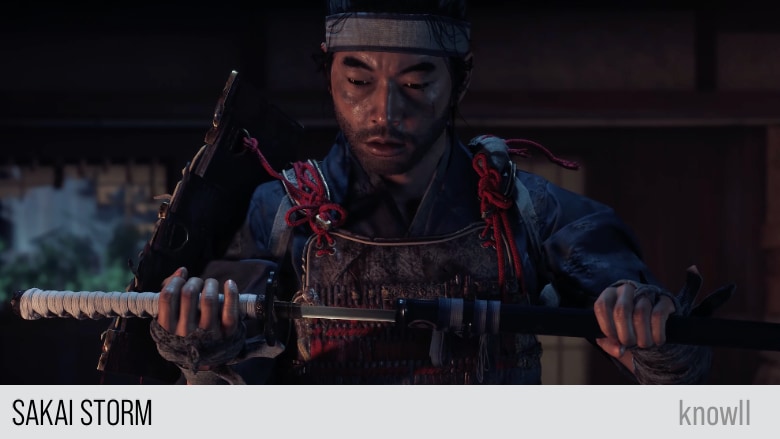
Sakai Storm is a family heirloom and will be with Jin from the beginning to the end of the game. As a lethal samurai, this is his primary weapon in fighting against the Mongol invaders. This katana is something that will grow with Jin throughout his journey.
Sakai Storm Upgrading - Stats and Appearance
Jin’s katana is extremely important to him. It’s also his primary weapon of choice from beginning to the end of the game. There are ways to improve this weapon, both in stats and appearance.
Bows, Kunai, and Smoke Bombs
As Jin transforms into becoming this feared warrior known as the Ghost, so too will some of his abilities and tactics.
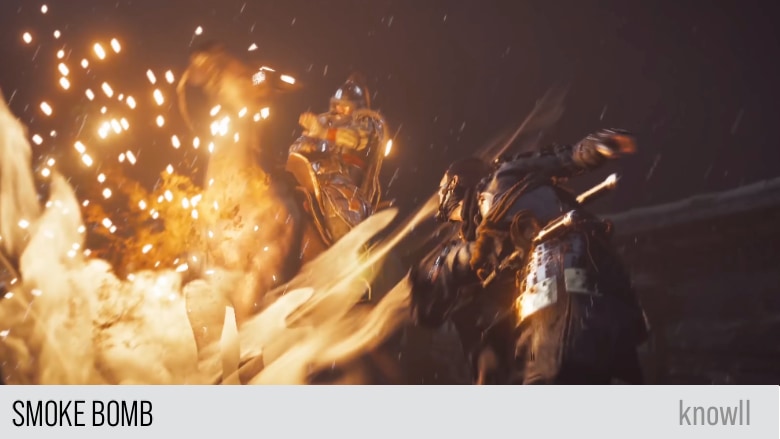
He will learn how to use a bow for picking off enemies at a distance or use throwable kunai and smoke-bombs at close proximity.
Armor Guide
Ghost of Tsushima's armor customization will give gamers the freedom while playing as Jin, both in appearance and capabilities. While fighting as a Samurai or sneaking around as the Ghost, Jin can equip different sets of armor.
That's because the armor in the game provides different utilities and mechanical advantages that can match the situation you are facing. It is not just cosmetics. Of course, fighting in style is also vital if fashion is your focus. Both convey your chosen playstyle.
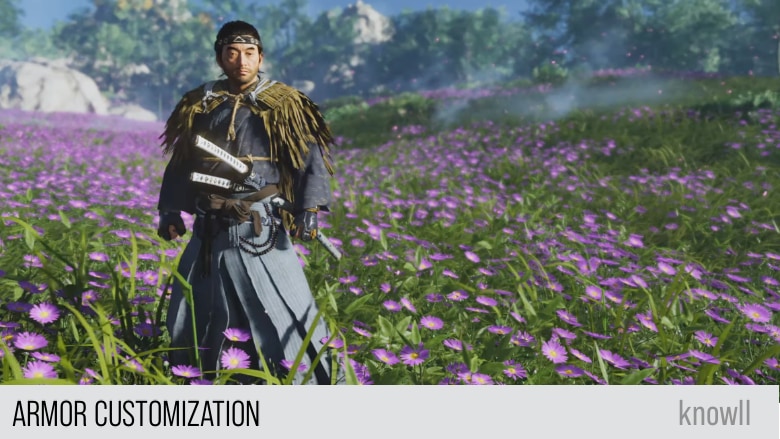
Dye Flowers
Not only can you mix and match the armor pieces, but you can also change their color. You will need special material for this though in the form of dye flowers.
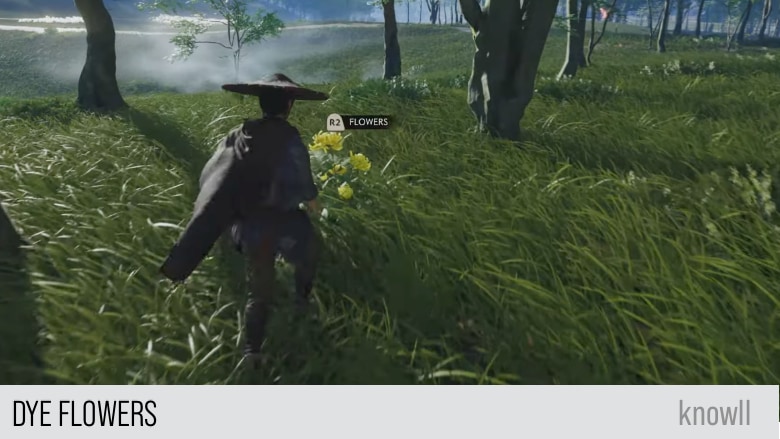
Find enough of them and you can change the color of an armor piece.
Combat Guide
While playing the game, you will face various enemies that use different kinds of weapons, like spears, axes, swords, dual blades, and even katanas. It is beneficial to become familiar with the combat mechanics.
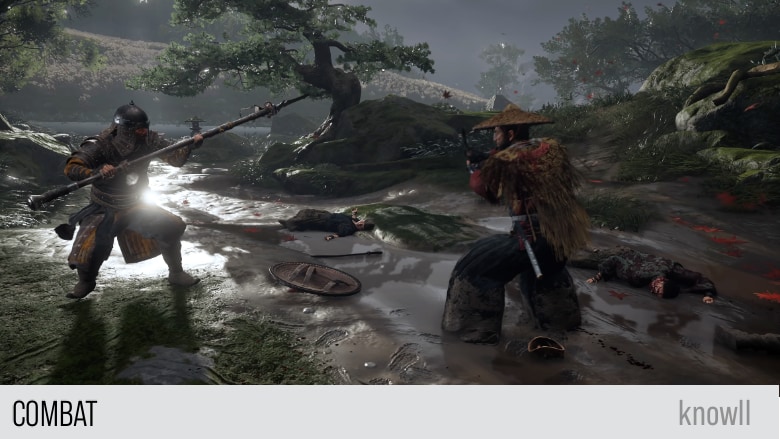
Resolve
Our first major combat mechanic is called Resolve. Conceptually, it is a measure of the samurai spirit that lets you push through the pain and injury you sustain.
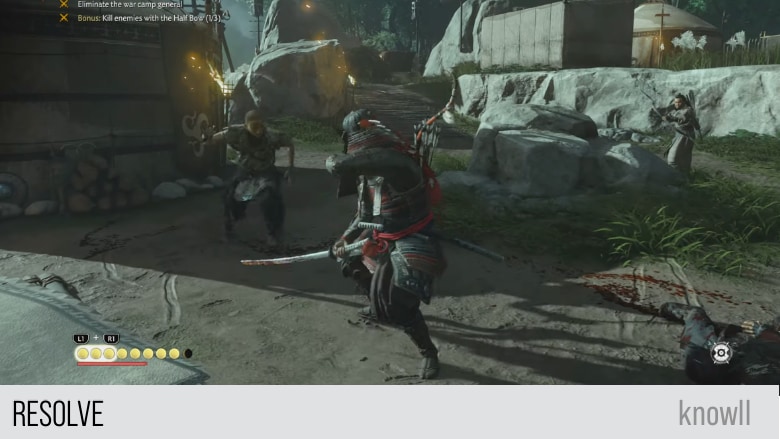
The circles are built up during combat and can then be used to either heal up or execute special attacks. You will have to decide whether you will save them for healing or for landing a deadly move.
Standoff
Duels are amazing in Samurai films, and Sucker Punch wanted to bring that experience in the game.
There will be a Flash of Insight, and then the icon will show for the Standoff.
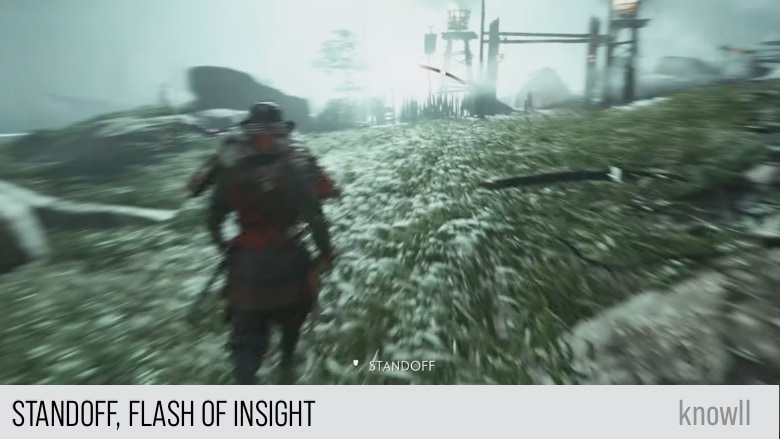
The screen will adjust as though you are in a Samurai film, with matching dark borders below and above the visible screen.
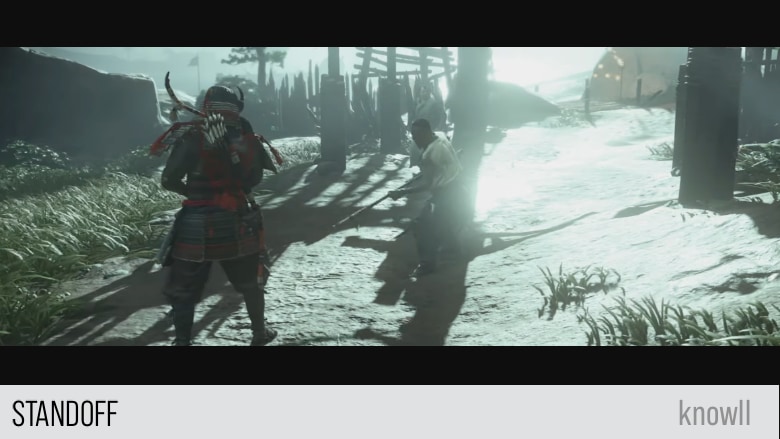
Dismemberment
There is dismemberment in the game. However, you won't be able to target specific body parts. In the scene below, the hand of the Mongol enemy has been cut-off.
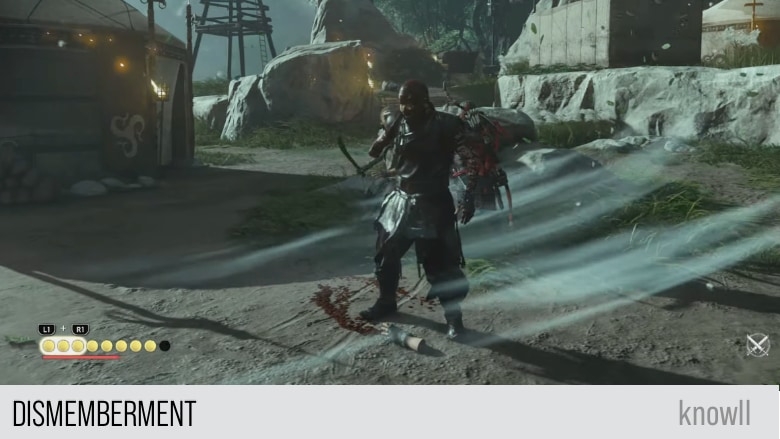
Decapitation
Jin can perform Decapitation to cut-off the head of his targets. It is one of the sneak attacks he can perform.
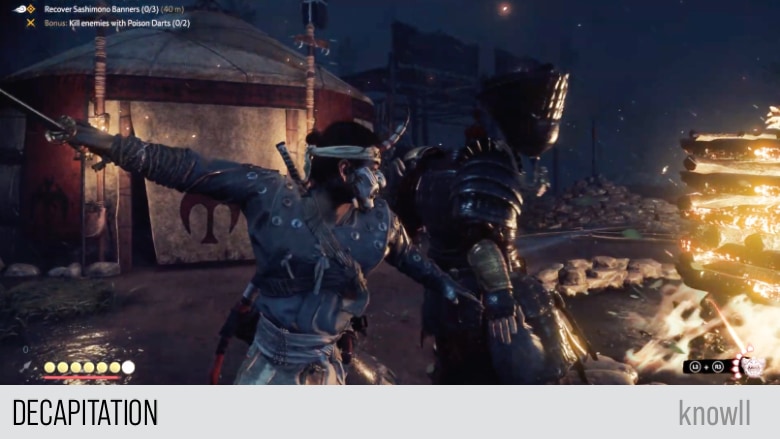
Parrying
You can parry enemy melee attacks and even projectiles, like arrows. Parry the target at the last possible moment to open them up.

By waiting to trigger L1 until the attack is about to land, you can change a block into a parry. The attacker will then become vulnerable to a counter-attack. Also, you will gain some amount of Resolve.
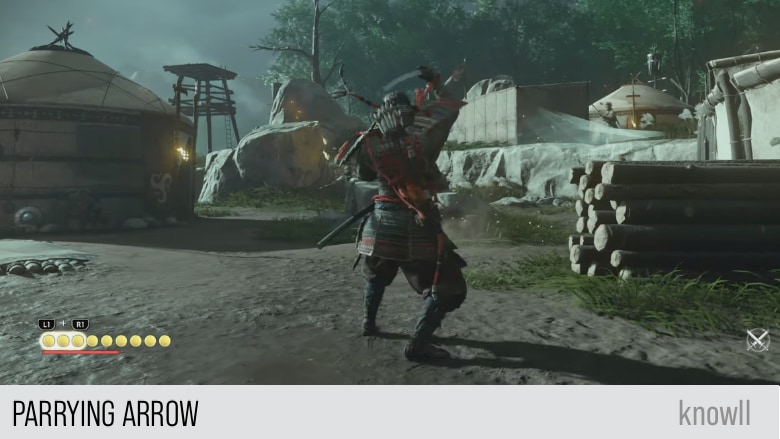
Perfect Parrying
With a proper upgrade, a new level of success opens up. Press L1 just as the attack is connecting and the parry becomes a perfect parry. This will stun the attacker and leave him open to a special, deadly counter-attack, rewarding you a big dose of Resolve.
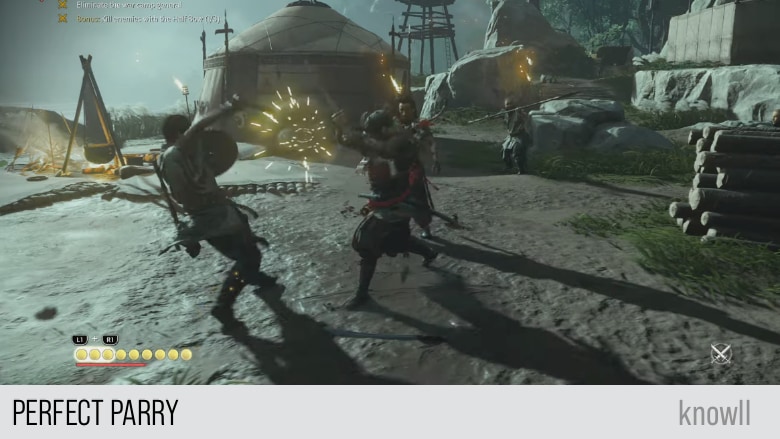
Blocking
Basic execution of blocking is simple — hold L1, block the attack.
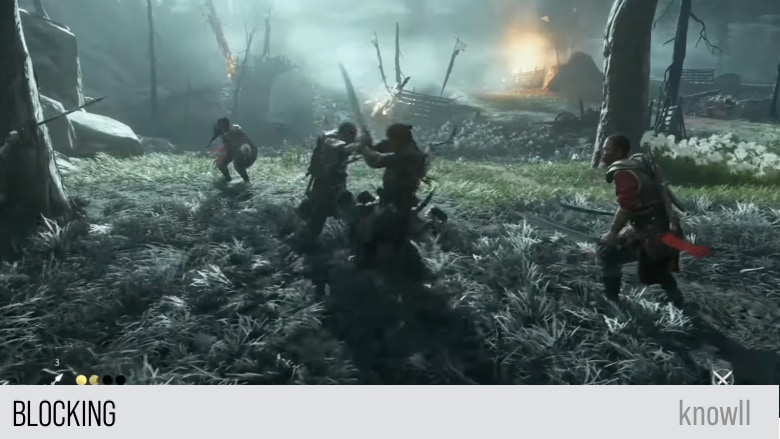
Dodging
You can dodge in the game and do a counter-attack.

Dodging has various animations.
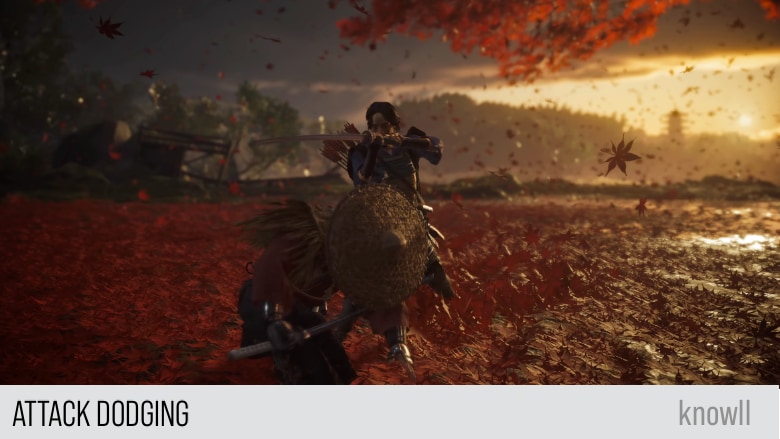
Attack Canceling
The game allows you to cancel an initiated attack so you can respond advantageously to your enemy. This is good for slow and powerful attacks that have a longer windup than light attacks. You might want to cancel the attack before it completes depending on your circumstances.
Using the Bow
In addition to the katana, you can also use bows in the game.

Target before unleashing.
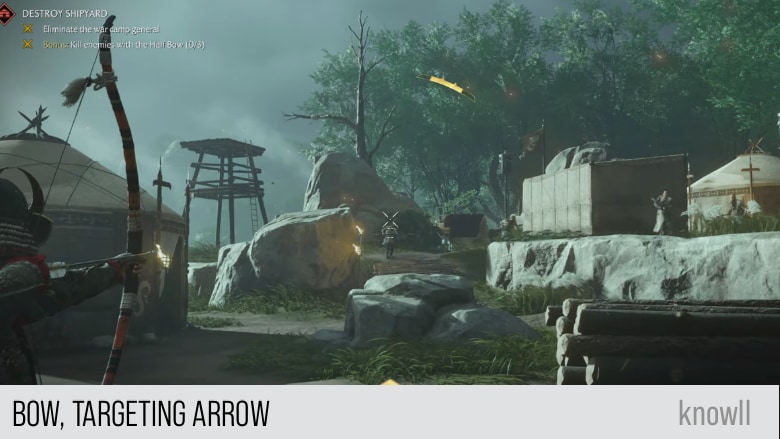
Stances
The game has a concept called Stances, which helps to give you more flexibility in fighting various types of enemies. You can easily switch from one Stance to another while in combat.
- Stone Stance
- Water Stance
- Wind Stance
- Moon Stance
Each Stance is meant to be particularly effective against a specific set of enemies in the game. Switching between Stances based on who you face amplifies your deadliness.
Stone Stance
Stone Stance is Jin's ancestral style, the traditional mode of fighting. It was developed to fight other swordsmen, so it will work effectively against Mongol swordsmen.
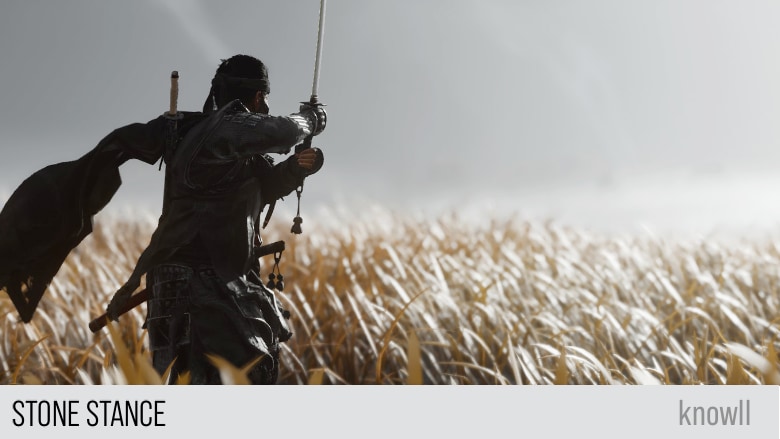
You will observe that the Stone Stance mostly uses two-handed attacks.
Two-Handed Attack, Slash
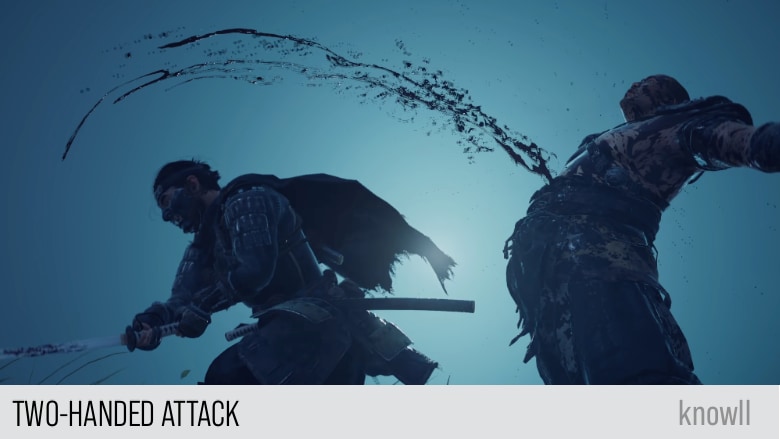
Two-Handed Attack, Stab
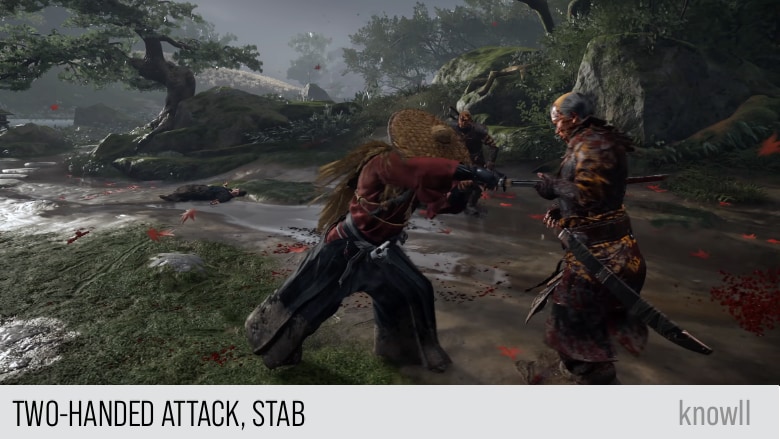
Water Stance
The Water Stance was developed by Jin as a result of his frustration in fighting the Mongol soldiers. It is very effective for shield-bearing enemies.
This combat style is characterized by one-handed attacks, a flurry of vertical and horizontal slashes.

The combo of the Water stance typically has a pattern.
First attack, upwards.
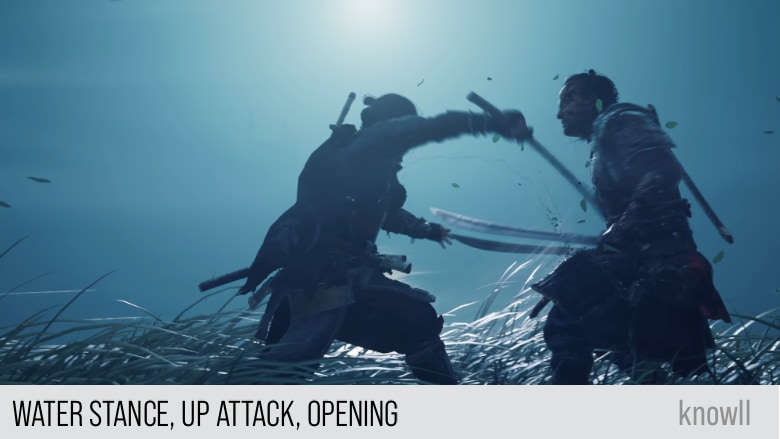
Second attack, downwards.
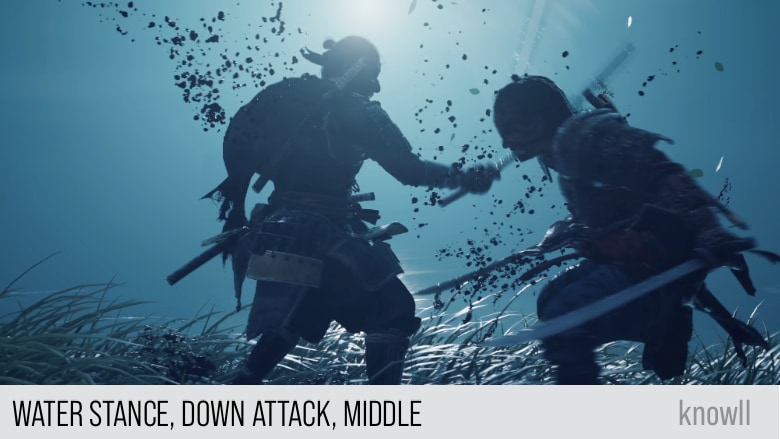
Third attack, upwards.
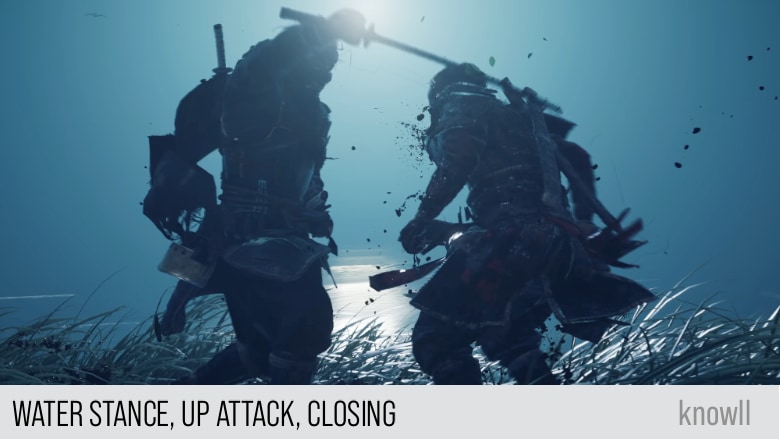
Distractions
Use distractions to bring enemies to their deaths.
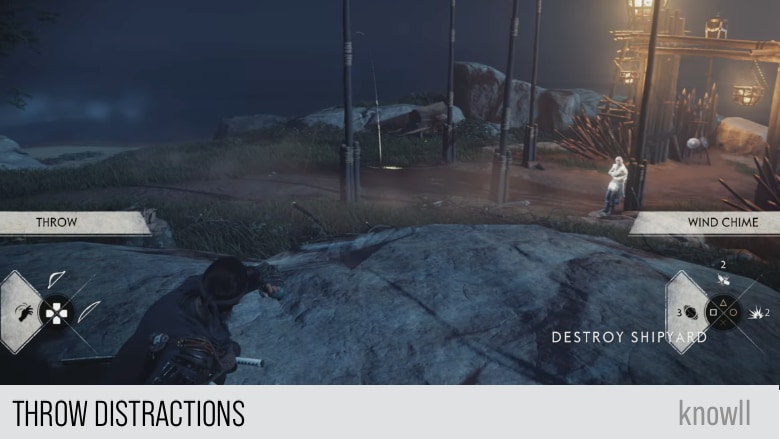
This will create vibrations in the air that can enable you to sneak into their backs. For distractions, you can use Wind Chime or Firecracker.
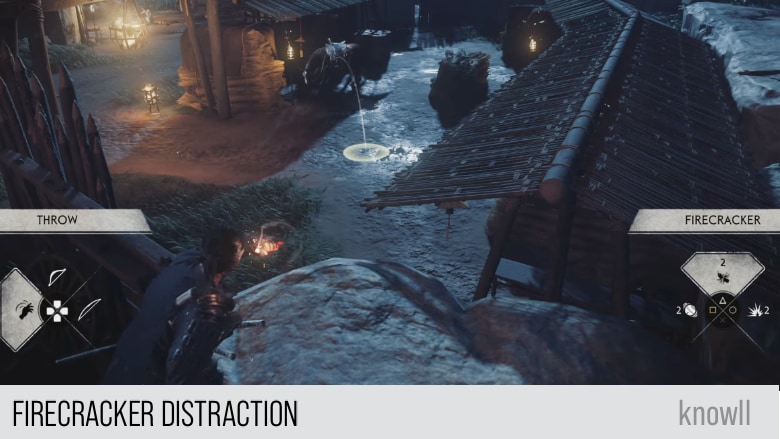
Assassination
Once you are able to distract the enemy and get into their backs, you will be able to execute an assassination.
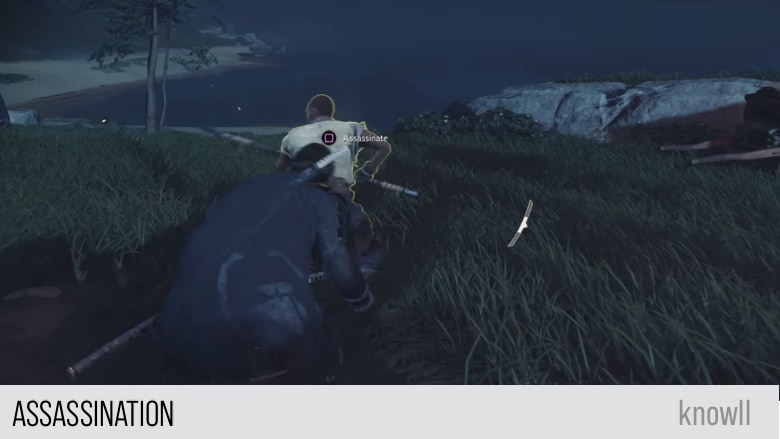
Chain Assassination
A more powerful variation of assassination, as it enables you to slay multiple enemies in a series of actions.
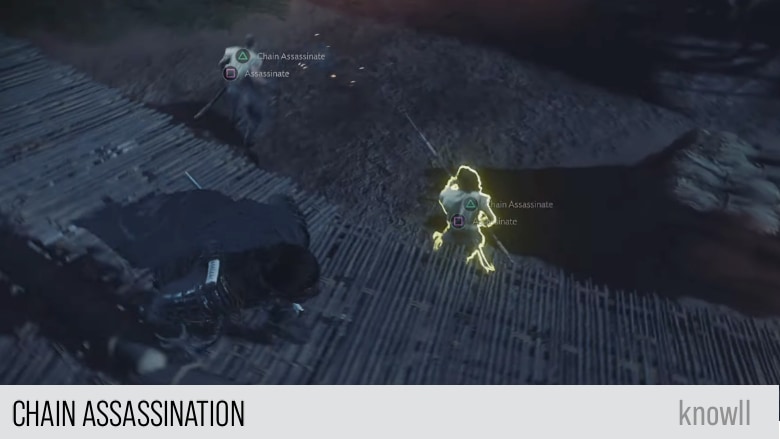
Chain Assassination, Setup
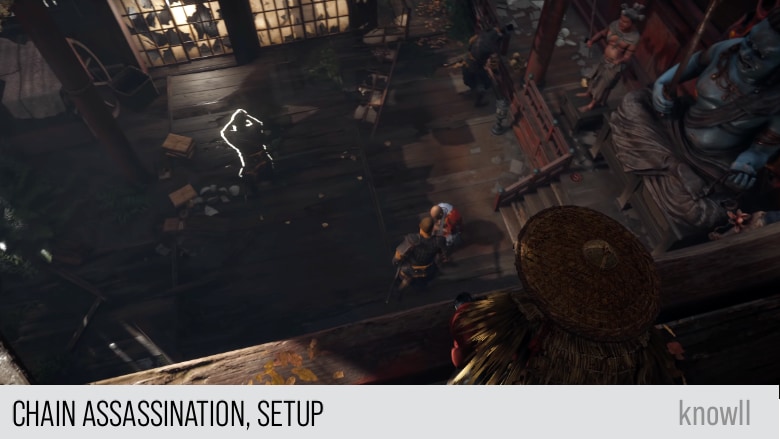
Chain Assassination, First Kill
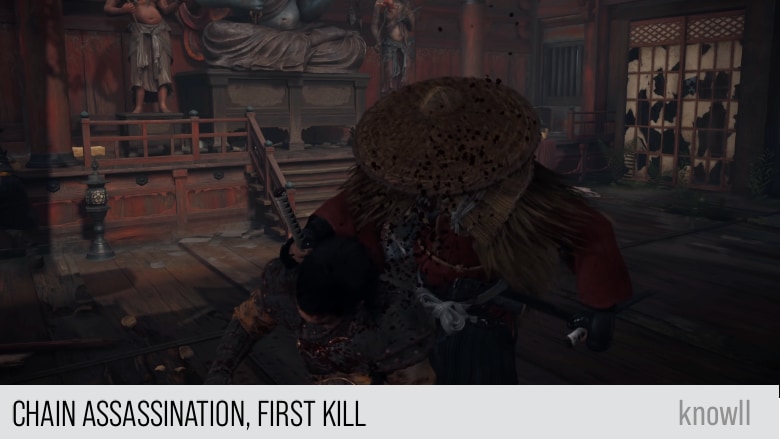
Chain Assassination, Second Highlight
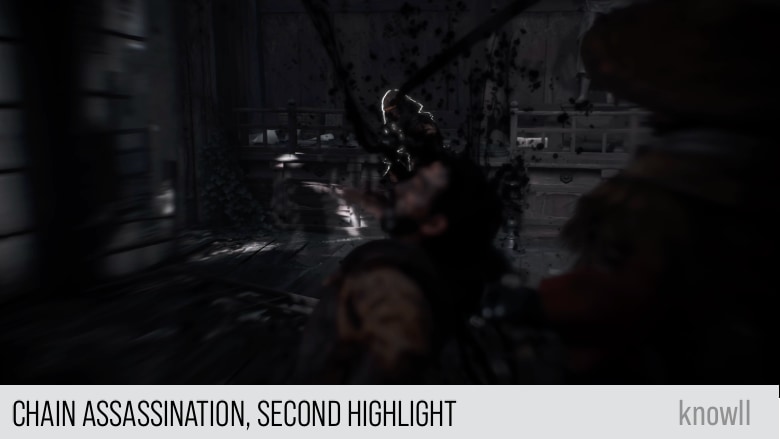
Chain Assassination, Second Kill
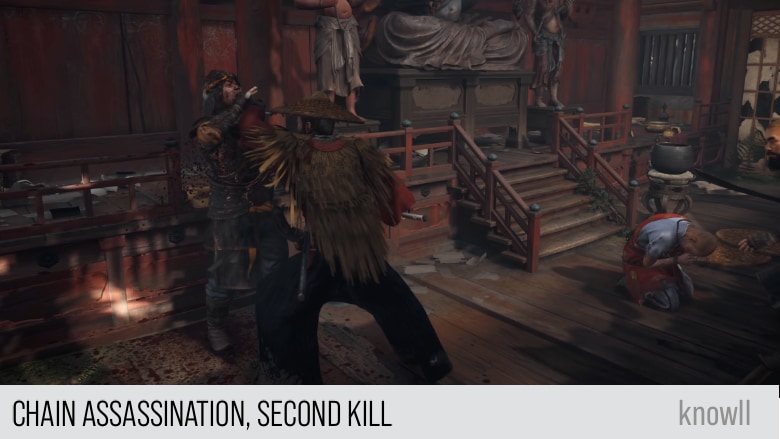
Chain Assassination, Third Highlight

Chain Assassination, Third Kill
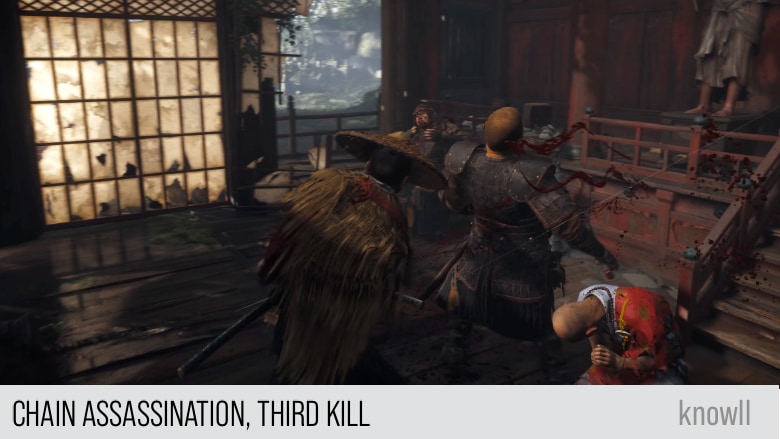
Slaughter
Another kind of sneak attack is called Slaughter (we will provide more details upon game release).
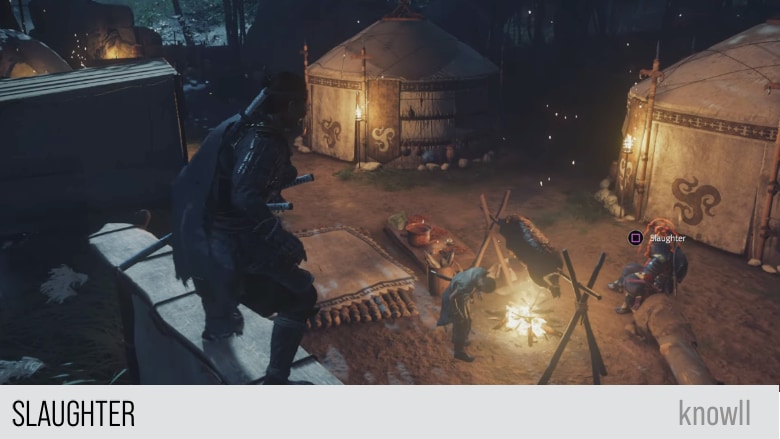
Smoke Bombs
Smoke bombs allow you to confuse an enemy that has seen you from a distance. It open leaves them for an attack.
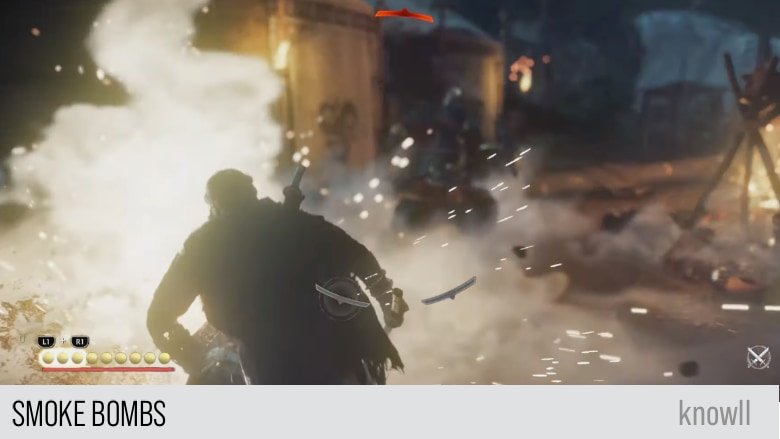
You can even use them on enemies riding horses.

Critical Strike
Another kind of sneak attack is called a Critical Strike (we will provide more details upon game release).
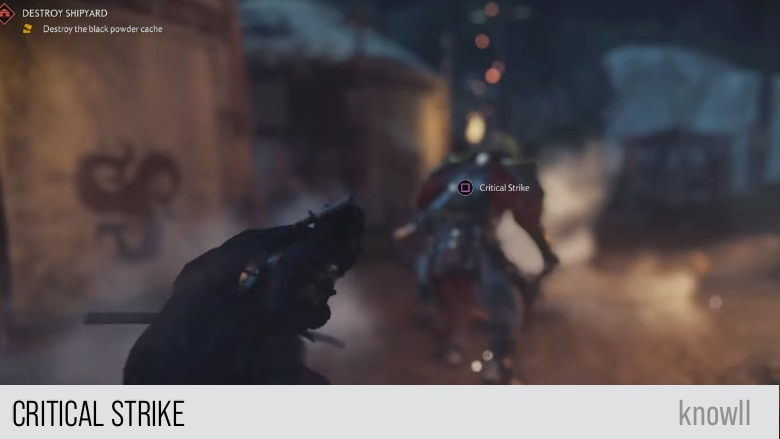
Using Kunai
When spotted, use a Kunai for a quick kill
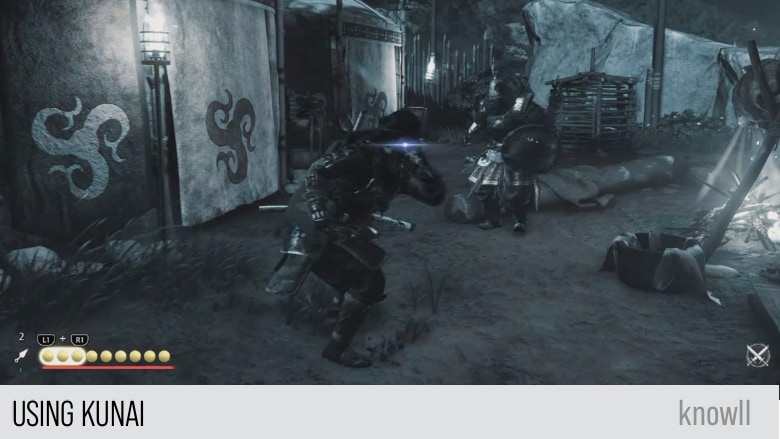
Fear as a Weapon
The Mongol soldiers will learn to fear the Ghost. Use that to your advantage.
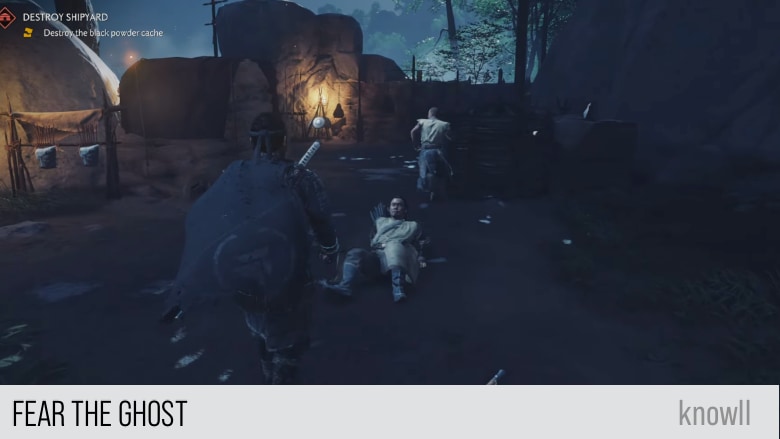
Red Attacks
While fighting enemies, you will soon observe an attack from them where the weapon glows with a red color. We have a guide for this which you can read through the link.
Red Attack - Spear
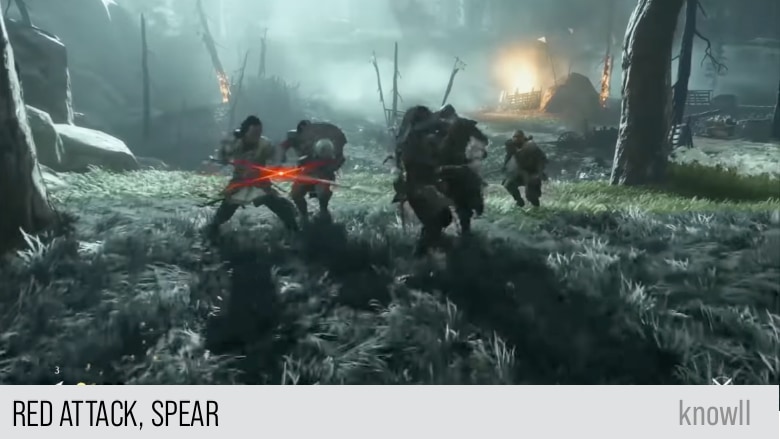
Red Attack - Dual Blades
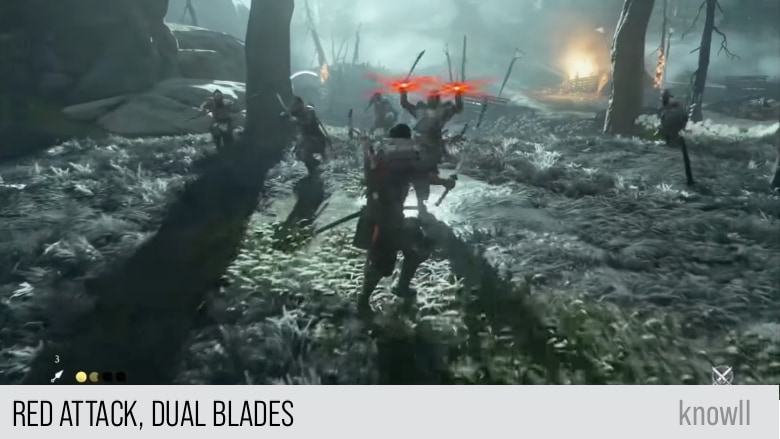
Red Attack - Shield
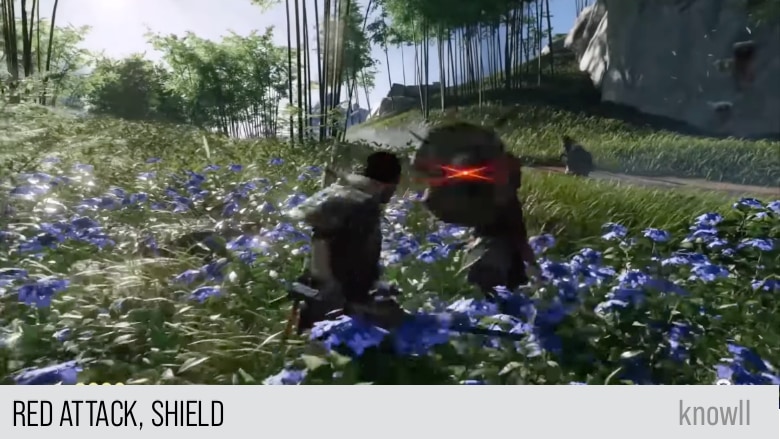
Items Guide
There are many items and collectibles in the game, but foremost among them is the head-piece called the Sakai Mask.
Sakai Mask
The most important non-weapon item in the game is Sakai Mask. It is what Jin wears when he turns into the Ghost.
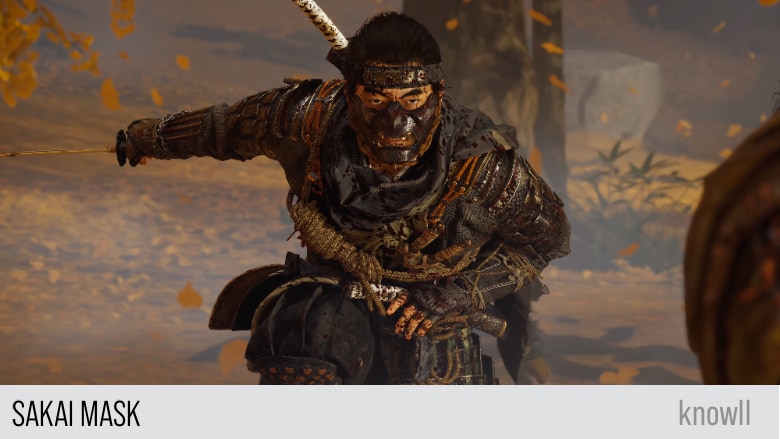
On the release week of the game, we will reveal where to find the Sakai Mask.
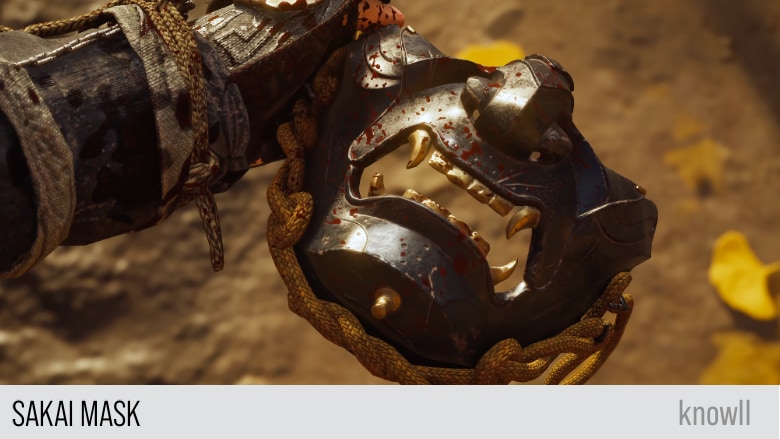
With the mask, Jin's transformation as the Ghost is complete.
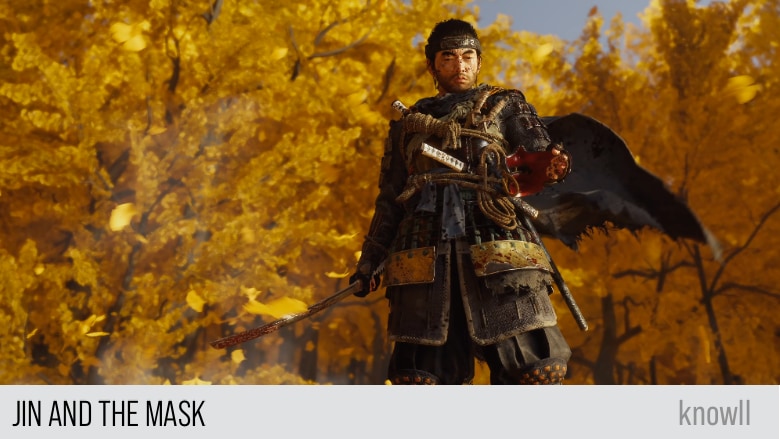
Charms Guide
Ghost of Tsushima's charms, also known as Omamori charms, are items that you can equip in a charm slot. While exploring the Island of Tsushima, you will discover and find these items. They will give you an edge in battle.
These charms provide various passive bonus abilities. There are different kinds of charms, including defense, stealth, and utility.
Charm of Okuninushi
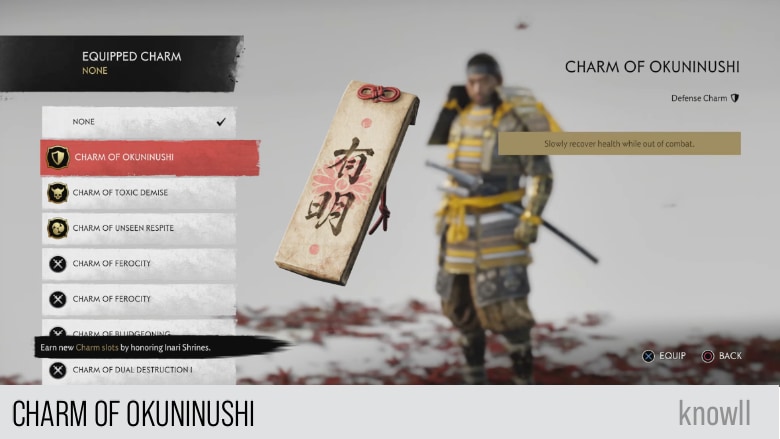
Charm of Toxic Demise
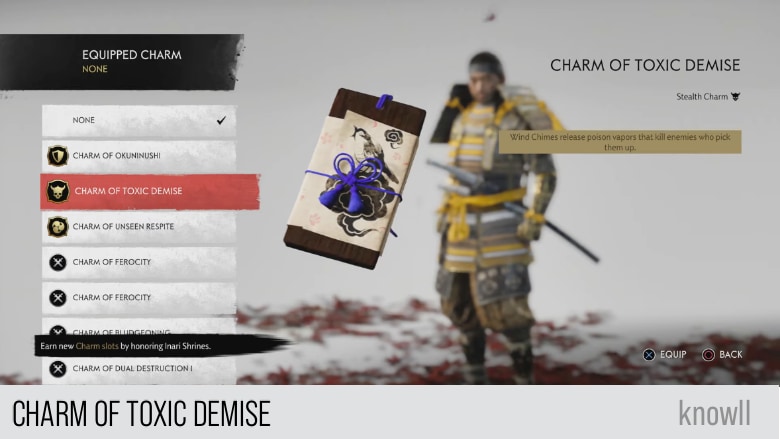
Charm of Unseen Respite
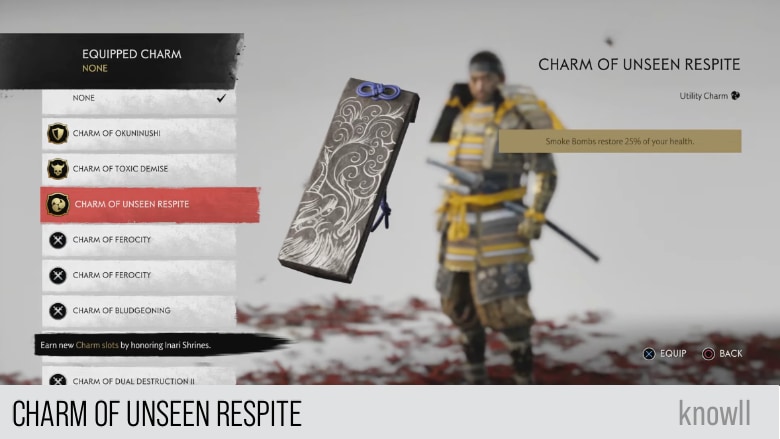
Photo Mode Guide
Ghost of Tsushima's Photo Mode allows you to capture captivating and mesmerizing shots that you can share with others.
Field of View
This helps you set the perspective on Jin and get the perfect angle for your shots.
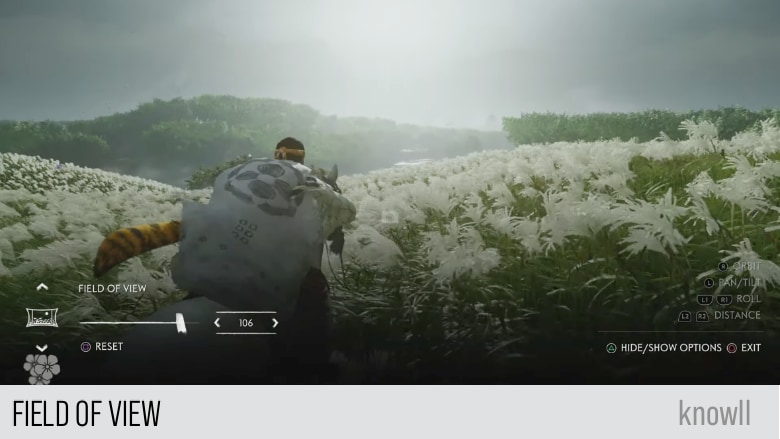
Color Grading
This helps you set the mood and capture the perfect color for your photo.

Depth of Field
This helps you focus on Jin and produce a dramatic effect for your photos.
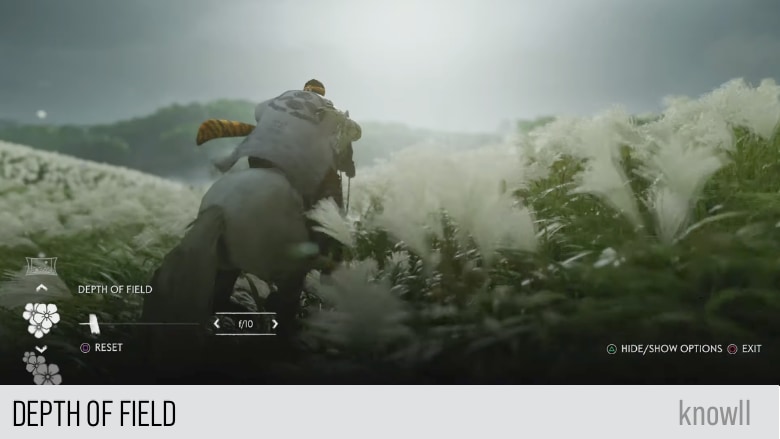
Jin Emotion
This helps you set the facial expression of Jin, so he conveys the correct emotion for your photo.
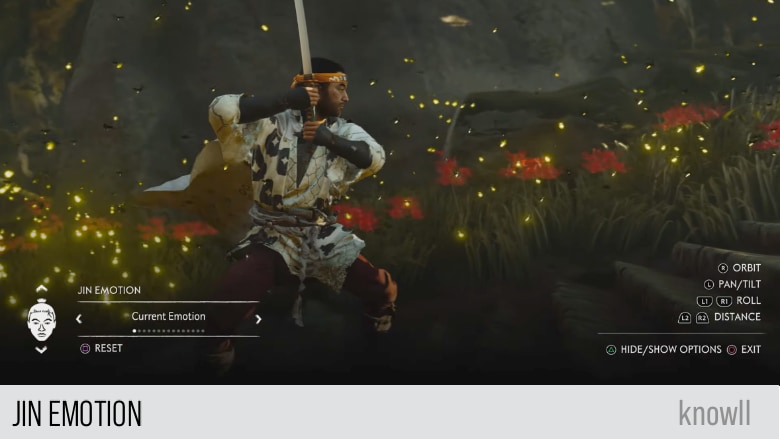
Wind Speed
Produce a dramatic and epic scene like the old Samurai movies with this feature.
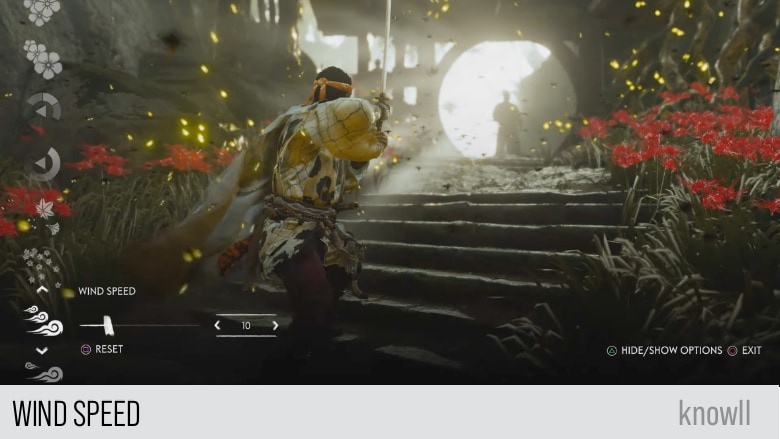
Wind Direction
Similar to Wind Speed, control the exact flow of the particles and set the "epicness" of your photo.
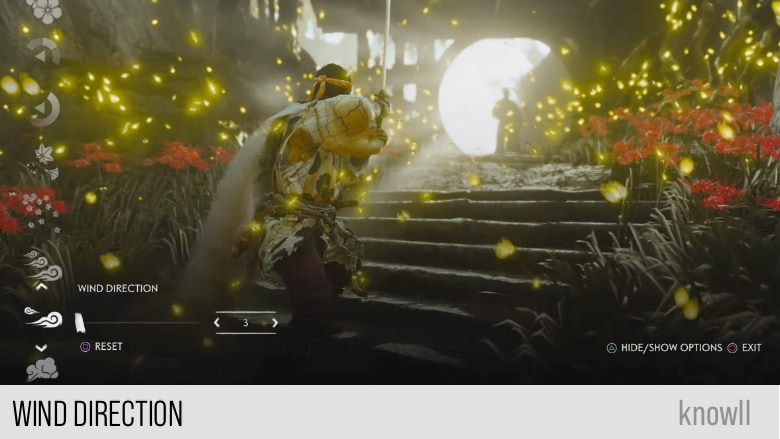
Music Customization
Music is the fastest path to the heart. This feature allows you to customize the music for your scene.
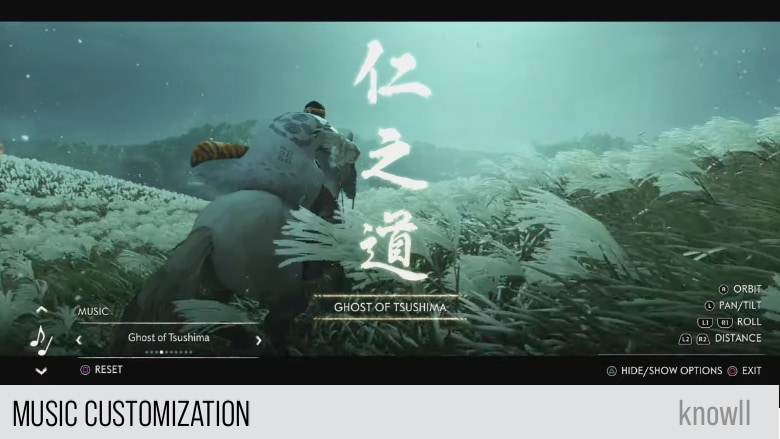
Particles
Control the kind of particles that flow in your epic scene. In tandem with the Wind controls shared above, you can create truly captivating scenes.
